
Project Gutenberg's Microscopes and Accessory Apparatus, by Ernst Leitz
This eBook is for the use of anyone anywhere at no cost and with
almost no restrictions whatsoever. You may copy it, give it away or
re-use it under the terms of the Project Gutenberg License included
with this eBook or online at www.gutenberg.net
Title: Microscopes and Accessory Apparatus
Catalogue No. 40
Author: Ernst Leitz
Release Date: April 12, 2011 [EBook #35842]
Language: English
Character set encoding: ISO-8859-1
*** START OF THIS PROJECT GUTENBERG EBOOK MICROSCOPES, ACCESSORY APPARATUS ***
Produced by Barbara Watson, Ross Cooling and the Online
Distributed Proofreading Canada Team at
http://www.pgdpcanada.net
All previous editions of this catalogue are superceded by the present one, which should be exclusively used in ordering.
Orders will be filled at once after their receipt.
In ordering care should be taken to give the number of each article desired and to state listprice.
To avoid delay and misunderstandings, we request that name and address be plainly written.
Goods are forwarded at the expense and risk of the purchaser.
Our instruments for use in Universities, Colleges, Schools &c. of the United States are by law free of duty and we shall be pleased to make specially low quotations for such orders.
ERNST LEITZ.
Since issueing our last catalogue, a number of new apparatus and accessories have been added. The following are the more important ones:
1. A completely new stand "A" with extra fine micrometerscrew transmitting its movement directly to the tube. The stand is of elegant appearance and large dimensions, making it especially well adapted for work in photo-micrography.
2. Stand I is now fitted out with the new special fine adjustment (each division 1/1000 mm).
3. Stand II with round centering stage.
4. Stand IV is replaced by a model of larger size.
5. Photo-micrographic apparatus for use in horizontal and vertical position, having joint for inclination, large size bellows and plateholder.
6. Large projection-apparatus for electric lamp of 30 Ampère with triple collecting lens of 210 mm aperture.
7. Objective 1 a with adjustable mounting and changeable magnification. It is an excellent objective of low power for general purposes, having a comparatively short working distance.
8. Objective 1 b with changeable magnification of lowest power, as far down as two diameters. It serves for drawing extended sections and specimens.
9. Saccharimeter after Mitcherlich improved form.
10. Trichinoscope, projection-apparatus of strong and simple construction.
Our American Branch house in New-York under the management of Mr. Wm. Krafft has now been established for over 10 years. This period has witnessed a gradual development of our business in the United States, making it necessary to establish some years ago a Western Branch in Chicago of which Mr. R. Gibson has charge.
The cordial reception our firm received has been most gratifying and we take this opportunity to thank our many patrons for their kind consideration.
It is our aim to co-operate with the scientists and construct new apparatus to meet their needs or improve others wherever this is possible.
The foregoing list of additions and improvements made since issueing our last catalogue is proof that we spare no time nor labor to hold pace with the increased wants of modern times.
We have now manufactured and sold over 71000 compound microscopes and 31000 oil immersion objectives, a large number of which are used in the laboratories of Universities, Colleges, and other Educational Institutions of the United States.
We are prepared at New-York and Chicago to repair our instruments or make alterations at short notice and at lowest prices. The optical part of a microscope should invariably be sent to the maker, as he is best in a position to repair same and has an added interest to bring a lens back to its original quality or even improve it.
Microscopes, bacteriological apparatus and all other scientific instruments or preparations expressly imported for use in educational institutions are exempt from duty.
Catalogues may be had on application by addressing:
In the manufacture of our objectives only such glass is employed as has been subjected to the most rigid scientific tests. By these the exact index of refraction and the exact degree of dispersion of the glass are determined, and with these data available it is possible to very perfectly correct both spherical and chromatic aberrations while still making use of wide angular apertures in the objectives.
The precise mathematical calculation, combined with accurate systematical working and testing methods, make it possible for us to guarantee our objectives to be all of equal and excellent quality.
Every objective before leaving our hands, is subjected to the most careful test, and only such lenses as are of the highest grade, are sent out.
For the past seventeen years we have used glasses manufactured by Schott & Co. of Jena. This glass has many points to recommend it for the construction of optical instruments, and only such kinds are employed by us, which have for many years been thoroughly tested as to their durability.
Our lenses are therefore absolutely permanent. Objectives of the earlier type which have become cloudy, we shall gladly repair.

The three illustrations given above afford an idea of the plan of construction of our achromatic objectives.
The first figure represents the plan of our low power objectives, and it will be noted that they consist of two doublets, or triplets each carefully corrected.[8]
The central figure shows the construction of our high power dry objectives. A hemispherical front lens is combined with two doublets or sometimes triplets. The front lens is the chief magnifier of the combination, while the other lenses serve to correct the various aberrations.
The Oil-immersion, represented by the last illustration consists of a front lens, hemispherical, behind which is a meniscus, which is in turn followed by a doublet and a triplet, these latter acting as the correcting lenses of the combination.
We manufacture both Achromatic and Apochromatic objectives. They differ in that the glasses made use of in the apochromatics and the manner in which they are combined permit a more perfect correction of chromatic aberration. This advantage is not gained without a certain sacrifice of simplicity in construction; by avoiding the use of flint glass having a high refractive index and substituting materials to take the place of crownglass. The apochromatics as a matter of fact do resolve the fine markings of test objects (butterfly scales and diatomes) somewhat more clearly than the achromatics, but the difference is slight and in ordinary stained microscope preparations is hardly detectable.
The correction of both achromatics and apochromatics is complete. The ordinary Huyghenian eye-pieces are consequently well adapted for use with the objectives of either construction. Only with the highest powers is it desirable to make use of the so-called "compensation" eye-pieces.
The achromatics and Huyghenian eye-pieces are also well adapted to the requirements of photomicrography, special objectives being unnecessary for this purpose. This statement is substantiated by the excellent results obtained with our achromatic objectives, as shown in the photomicrographs accompanying our brochure on Photomicrography:—"Anleitung zur Mikrophotographie".
In making use of the higher power objectives—from No. 5 on—it should be remembered, that the lenses are corrected for cover glasses of 0,17 mm in thickness and for a microscope tube-length of 170 mm. When using the oil-immersion objectives it is particularly desirable, that this exact tube length should be employed. With a view to facilitate the adjustment of the tube-length the draw tubes of all our larger stands are graduated in millimeters, the scale[9] indicating the exact length of the microscope tube in any given position of the draw tube. In this connection it should be remembered, that the width of the collar of the nose-pieces is 15 millimeters, and that consequently, when a nose-piece is attached to the tube the reading of the draw tube scale should be 155 mm instead of 170 when the adjustment is proper.

The above sketch may serve to make clear the advantages of the immersion objectives over those of the dry series. It is intended to represent diagrammatically a section through a cover-glass and the front lens of an objective, one half of the figure representing the conditions present in the case of the Oil-immersion, the other those which are present in the dry objectives. It will be noticed that by the interposition of a drop of oil of the same index of refraction as the glass between the cover-glass and the objective the refraction which occurs in the dry system when the light leaves the upper surface of the cover-glass is done away with. Since this second refraction is attended with much loss of light it must be evident, that in the immersion system a much greater quantity of light enters the objective than is possible, other things being equal, in objectives of the dry system.[10]
If we let u represent one half the angular aperture of an objective, represented in the diagram by D'BN in the case of the immersion, and n the index of refraction of the medium interposed between the cover-glass and the objective we have in the formula n sin. u a mathematical expression of the optic power of the various systems of lenses, or in other words for what is designated the numerical aperture.
The following table gives the numerical apertures of objectives of the various systems and of various angular apertures. In the dry system n., representing the index of refraction of air is taken as 1.00; in the immersion systems n equals 1.33 for water, 1.52 for cedar oil and 1.66 for monobromnaphthalin. A glance at the table will suffice to show the great advantage which the immersion objectives have over those of the dry series.
| Angular aperture 2 u |
10° | 20° | 30° | 40° | 50° | 60° | 70° | 80° | 90° | 100° | 110° | 120° | 130° | 140° |
| Dry series n = 1,00 |
0,09 | 0,18 | 0,26 | 0,34 | 0,42 | 0,50 | 0,57 | 0,64 | 0,71 | 0,77 | 0,82 | 0,87 | 0,91 | 0,94 |
| Water-Immersion n = 1,33 |
0,12 | 0,24 | 0,35 | 0,46 | 0,56 | 0,66 | 0,76 | 0,85 | 0,94 | 1,02 | 1,09 | 1,15 | 1,20 | 1,25 |
| Homogeneous Oil-Immersion n = 1,52 |
0,14 | 0,26 | 0,40 | 0,52 | 0,64 | 0,76 | 0,87 | 0,98 | 1,07 | 1,16 | 1,24 | 1,32 | 1,38 | 1,43 |
| Monobromide of Naphthaline-Immersion n = 1,66 |
0,15 | 0,29 | 0,43 | 0,57 | 0,70 | 0,83 | 0,95 | 1,07 | 1,17 | 1,27 | 1,36 | 1,44 | 1,50 | 1,56 |

| Focal length mm | 64 | 42 | 35 | 24 |
| Price $ | 20 | 18 | 18 | 18 |
It is designed principally for drawing extended sections and large specimens, and consists of two adjustable doublets. By varying their distance, a changeable magnification down to two diameters may be obtained.
Price $8.—
| Number | 0 | I | II | III | IV | V |
| Focal length mm | 50 | 40 | 35 | 30 | 25 | 20 |
The objectives designed for the Edinger apparatus of 64, 42, 35, and 24 mm focal distance have been found to be very useful for a number of purposes and have come into great favor.
(see. Dr. Kaiserling: Praktikum der wissenschaftlichen Photographie p. 263).
| No. of Objective |
Focal length |
Numerical Aperture (num. aper.) |
Micrometer Values | Price $ |
| { 1* { 1 Low power { 1a Dry Series { 2 { 3 { 4 |
44 mm (1-3/4") | 0,09 | 0,054 mm = 54µ | 3.25[1] |
|---|---|---|---|---|
| 44 mm (1-3/4") | 0,09 | 0,054 mm = 54µ | 6 | |
| 39-27 mm | 0,06—0,10 | 50—26µ | 10 (adjustable mounting) | |
| 30 mm (1-1/4") | 0,14 | 0,028 mm = 28µ | 6 | |
| 18 mm (3/4) | 0,28 | 0,015 mm = 16µ | 6 | |
| 8 mm (1/3) | 0,55 | 0,009 mm = 9µ | 10 | |
| High power { 5 { 6 (Fluorite) { 6a { 7 (Fluorite) { 7a " { 8 " { 9 |
5,8 mm (1/4") | 0,77 | 0,0045 mm = 4,5µ | 10 |
| 4,4 mm (1/6") | 0,82 | 0,0034 mm = 3,5µ | 12 | |
| 4,4 mm (1/6") | 0,82 | 0,0034 mm = 3,5µ | 16[2] | |
| 3,2 mm (1/8") | 0,85 | 0,0026 mm = 2,6µ | 12 | |
| 3,2 mm (1/8") | 0,85 | 0,0026 mm = 2,6µ | 16[2] | |
| 2,5 mm (1/10") | 0,87 | 0,0020 mm = 2,0µ | 16 | |
| 2,2 mm (1/12") | 0,87 | 0,0017 mm = 1,7µ | 24 | |
| Water-Immersion 10 | 2,2 mm (1/12") | 1,10 | 0,0017 mm = 1,7µ | 26 |
| { 1/10 Homogeneous Oil-Immersion { 1/12 { 1/16 |
2,5 mm (1/10") | 1,30 | 0,0022 mm = 2,2µ | 30 |
| 2,1 mm (1/12") | 1,30 | 0,0017 mm = 1,7µ | 40 | |
| 1,7 mm (1/16") | 1,30 | 0,0014 mm = 1,4µ | 60 |
[1] Objective 1* consists of only one doublet, carefully corrected. It is sufficient for many purposes, though it does not possess the same brilliancy of field as the No. 1 objective.
[2] The objectives 6a. and 7a. are better corrected in achromatism than the regular No. 6 and 7.
| Objectives | Eye-pieces | Objectives | |||||
|---|---|---|---|---|---|---|---|
| 0 | I | II | III | IV | V | ||
| { 1* { 1 Low power { 1a Objectives { 2 { 3 { 4 |
12 | 18 | 22 | 26 | 30 | 40 | Achromatics |
| 12 | 18 | 22 | 26 | 30 | 40 | ||
| 6-9 | 9-15 | 11-19 | 13-21 | 18-29 | 24-35 | ||
| 25 | 33 | 40 | 50 | 60 | 80 | ||
| 45 | 60 | 70 | 80 | 105 | 130 | ||
| 75 | 100 | 115 | 135 | 180 | 230 | ||
| High Power { 5 Objectives { 6 and 6a (Cover-glass { 7 and 7a thickness { 8 0,17 mm) { 9 |
140 | 180 | 210 | 250 | 325 | 420 | |
| 200 | 255 | 300 | 350 | 460 | 600 | ||
| 260 | 335 | 400 | 450 | 600 | 780 | ||
| 300 | 400 | 450 | 550 | 700 | 940 | ||
| 380 | 500 | 575 | 700 | 900 | 1150 | ||
| Water-Immersion { 10 | 405 | 535 | 610 | 745 | 950 | 1200 | |
| Homogeneous { 1/10 Oil- { 1/12 Immersion { 1/16 |
310 | 415 | 470 | 575 | 730 | 940 | |
| 435 | 555 | 650 | 800 | 1000 | 1300 | ||
| 520 | 700 | 800 | 950 | 1250 | 1680 | ||
| { 16 Dry Lenses { 8 { 4 |
45 | 60 | 70 | 85 | 110 | 140 | Apochromatics |
| 95 | 125 | 145 | 170 | 225 | 295 | ||
| 210 | 270 | 315 | 375 | 500 | 635 | ||
| Oil-Immersion 2 | 390 | 510 | 585 | 705 | 920 | 1180 | |
| Objectives | Focal length mm |
Numerical Aperture |
Micrometer Values |
Price $ |
| { 16 Dry Series { 8 { 4 |
16 | 0,30 | 0,015 mm | 24 |
|---|---|---|---|---|
| 8 | 0,65 | 0,007 mm | 32 | |
| 4 | 0,95 | 0,003 mm | 48 with correction collar |
|
| Homogeneous Oil-Immersion { 2 |
2 | 1,30 | 0,002 mm | 100 |
| Eye-pieces | 4 | 6 | 8 | 12 | 18 |
| Price $ | 6.50 | 6.50 | 10 | 10 | 8 |
| Objectives | Eye-pieces | ||||
|---|---|---|---|---|---|
| 4 | 6 | 8 | 12 | 18 | |
| { 16 Dry Series { 8 { 4 |
70 | 100 | 125 | 155 | 225 |
| 140 | 200 | 260 | 325 | 465 | |
| 300 | 430 | 550 | 675 | 1000 | |
| Oil-Immersion 2 | 575 | 820 | 1080 | 1500 | 2250 |

Until very recently we have manufactured no arrangement for changing oculars on the microscope. This was due in part to the fact that there was no great demand for such an accessory and in part to the clumsiness of all those revolving eye-pieces which changed the entire ocular. The latter of these difficulties has been overcome in our present revolving eye-piece by such an adjustment of the collecting or lower lens of the eye-piece that it may remain permanently in position, the eye lens of the combination alone moving in the revolver. So accurate is the construction of the revolver and so carefully are the lenses adjusted that the eye-pieces may be changed while a specimen is in focus on the microscope stage without a readjustment of the focus.
The revolving eye-piece is also particularly well adapted to use as a micrometer ocular, for when the eye lens is turned aside a micrometer scale may be inserted and rests upon the diaphragm of the eye-piece. Once adjusted in this way the micrometer values are the same for all the eye lenses of the combination.
| Prices: Double revolving Eye-piece, without eye lenses | $4.— |
| Each eye lens | $1.25 |
| Eye-piece Micrometer, No. 86 | $2.— |
For the past thirty years division of labor has been employed to the utmost possible extent in the manufacture of our microscopes. This principle has been applied to our machinery as well as to our workmen, with the result that we have gradually accumulated a large plant of special machinery of the most accurate construction, each machine especially adapted to the manufacture of some particular part of our microscopes. By this development of mechanical appliances for microscope manufacture two ends have been attained:—The greatest accuracy and uniformity of construction of our microscopes has been made possible, while at the same time it has been possible to cheapen the cost of manufacture. Instruments which are the product of delicate machinery must always be more uniform, more accurate and should be less costly than those manufactured by hand.
In the following remarks we refer more particularly to the larger microscope stands of our manufacture and draw attention to those parts which should be present in every well equipped microscope.
The elements of these microscopes are:
1. The foot and upright support with joint for inclination,
2. The stage,
3. The sub-stage, with condenser, iris diaphragm and mirror,
4. The body with the adjustments,
5. The tube, carrying eye-piece, nose-piece and objectives.
1. The foot and upright support are solid and are of such weight and shape as to permit inclination of the body of the microscope to a horizontal position. The foot is horse-shoe shaped and is made to touch the table at three points, thus insuring stability even on a surface which is not entirely level. Inclination of the body of the microscope is permitted by a joint in the upright, which joint[17] may be fastened in the larger stands by a set-screw operated by a lever. Stands Ia and IIb are also made with the English foot. Abundant space is left under the stage for the various attachments of the sub-stage.
2. The stage of Stands A, I, Ia and II is round, revolving and centering. The centering arrangement consists of two small thumb-screws so situated at the sides of the stage as to control motion of the stage in all directions, thus to a limited extent serving the purpose of a mechanical stage.
The other microscope stands have square immovable stages, sufficiently large for general microscopic work. For the examination of very large sections two instruments are manufactured: the Nebelthau sliding microscope (p. 50) and the stand after Dölken (p. 52). The former is for magnifications up to 120 diam, whereas the latter can be used with any magnification.
3. The sub-stage carries a plane and concave mirror, the condenser and the diaphragm for regulating the illumination of the object.
The Condenser is so adjusted as to concentrate the rays of light about 2 mm above its surface, which is the average thickness of the microscopic slides, under an angle equal to the angular aperture of the highest power objective, which is about 120°.
In the lower power objectives the angular aperture is to be reduced by the iris diaphragm.
To focus the Condenser properly it is adjustable by rack and pinion movement on Stands A, I, Ia, Ib, and by side screw on Stands II and IIa.
4. The body of the microscope carries the tube and is fitted with two adjustments for focussing; a coarse adjustment and a fine adjustment. The smooth working of these adjustments is one of the chief requirements of a good microscope.
The coarse adjustment consists of rack and pinion and moves the tube of the microscope in a vertical groove with the least possible friction. The teeth of the rack and pinion are set obliquely to the axis of the tube and are so adjusted that two teeth of each are always interlocked, thus avoiding all possibility of slipping or loss of motion in the movement.[18]

The fine adjustment consists of a micrometer screw which moves the tube and arm of the microscope supporting the coarse adjustment vertically upon a triangular column. This column is virtually a continuation upward of the upright support of the base of the microscope. Around the column is a broad collar so accurately fitted that it moves smoothly upon it with a minimum of friction and still without lateral motion, the movement being controlled by means of a micrometer screw at the top of the column. The head of this micrometer screw, a section of which is shown in the accompanying figure, is milled and is graduated in such a way as to indicate the exact degree of motion of the microscope tube which is accomplished by turning the micrometer screw, each division of the graduation corresponding to a motion of the tube through 1/100 millimeter, and a complete revolution of the screw corresponding to a motion of the tube through ½ millimeter. The accuracy of this adjustment and the smoothness of its motion must be conceded to be a triumph of mechanical skill.
Stands A. and I. are fitted with a new fine adjustment device (one division on the micrometer screw corresponding to 1/1000 mm.) which is fully described on pages 25-26.
5. The tube of the microscope encloses a second tube, or draw-tube, which latter carries the eye-piece, and is so graduated as to indicate the exact length of tube in use at any time. The lower end of the tube has a thread into which the various objectives or a nose-piece screw. Tube and objectives are provided with the so-called "Society screw".
The nose-piece has now become an almost indispensable part of a working microscope. It can, however, be used to best advantage only on such stands as are provided with a coarse adjustment by rack and pinion. Aside from the advantage derived from the[19] rapid changing of objectives, which it permits, it is so accurately made and centered as to materially facilitate the focussing of the various objectives. It is only necessary to focus with the fine adjustment to obtain a view of the same microscope field which had been under observation before the change was made.
As it is necessary for this purpose that the objectives should be accurately adjusted to the nose-piece, it is very desirable that in ordering an instrument its nose-piece should be ordered at the same time if one is to be used, as subsequent ordering may necessitate the return of the stand and objectives to us.
Stands A, I, Ia, Ib, II, IIa, IIb and III are those which are best suited to fine microscopical investigations. Among them the physician and bacteriologist will find an instrument entirely suited to his particular needs.
Stand III is now provided with rack and pinion adjustment.
Stands IV and V are small instruments, which serve nevertheless many purposes where the more elaborate outfits are unnecessary. They make excellent laboratory stands for elementary courses in microscopy.
In Stands IV and V the coarse adjustment is by means of sliding tube. They are all provided with fine adjustment by micrometer screw.
Stand VI is provided with rack and pinion adjustment only. It has a large stage, and is particularly intended for searching for trichinae and for similar examinations where a very strong durable stand is desired and where the use of high power objectives is unnecessary. It may also be useful as an auxiliary stand for purposes of demonstration in laboratories.
Stands III, IV, V, VI have no joint for inclining the body.
Stands A, I, Ia, Ib, II, IIa, IIb, III, IV have mahogany cases (provided with a nickelled handle), in which the microscopes stand.
Stands V and VI are laid in mahogany boxes.
These cases are furnished with the microscopes without extra charge, when a complete outfit, including oculars and objectives is purchased.
Object clamps and test objects accompany every microscope.
The objectives to Stands A, I, Ia, Ib, II, IIa, IIb are in brass boxes; those for Stands III, IV, V and VI are in morocco cases.
The apparatus includes the following parts:
Cylinder iris diaphragm.
Swing-out condenser.
Diaphragm carrier with iris diaphragm.
Plane and concave mirror.
The cylinder iris diaphragm comes into play when the condenser is swung out of position. To do this the diaphragm carrier is turned to the side as shown in the diagram, a small knob is pressed, which liberates the condenser, and the latter is swung out to the side.
The regulation of the cylinder iris diaphragm is accomplished by means of a lever. Before the condenser is swung back into position the cylinder iris should be opened to its fullest extent. The lower iris diaphragm is for use in connection with the condenser only. It is regulated by means of a small knob. A horizontal rack and pinion arrangement permits oblique illumination, and a vertical rack and pinion permits adjustment of the whole sub-stage. By these means a most perfect control of the illumination of the object is assured. Ground or colored glass discs may be inserted above the iris diaphragm if modification of the light is desired.
$30.—
This illuminating apparatus may also be fitted to Stands Ia and Ib.[21]


The following are the parts of this apparatus:
Cylinder diaphragm with 3 stops of different apertures.
Condenser.
Diaphragm carrier with iris diaphragm.
Plane and concave mirror.
To substitute the condenser for the cylinder diaphragm the diaphragm carrier is turned to the side and the cylinder diaphragm is drawn out of the sleeve which holds it in position and into which the condenser readily fits. The diaphragm carrier is then turned back into position and the amount of light regulated by manipulating the knob controlling the size of the iris. The whole sub-stage may be raised or lowered in the optical axis by means of a rack and pinion, and a similar arrangement permits lateral illumination by moving the iris diaphragm in the horizontal plane.
Ground glass and colored plates may be inserted above the iris diaphragm.
$24.—
The condenser and iris diaphragm form one piece, giving central but no oblique illumination. The whole apparatus may be raised and lowered in the optical axis by means of a screw. The cylinder diaphragm may be inserted in place of the condenser. A ring below the iris diaphragm permits the insertion of glass discs for the purpose of modifying the light.
$12.—
The same as for II and IIa fitted in a fixed sleeve; without the side-screw.
$10.—
[23]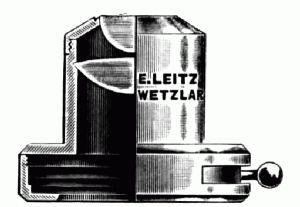
The small illuminating apparatus consists of a somewhat smaller condenser with iris diaphragm and can be adjusted to the Stand IV, when it has the cylinder diaphragm.
$8.—
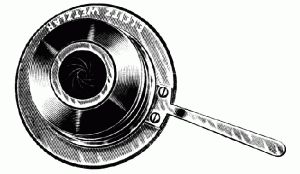
A cylinder iris diaphragm can be furnished in place of the ordinary cylinder diaphragm of Stand II, IIa and IIb at an additional cost of
$6.—
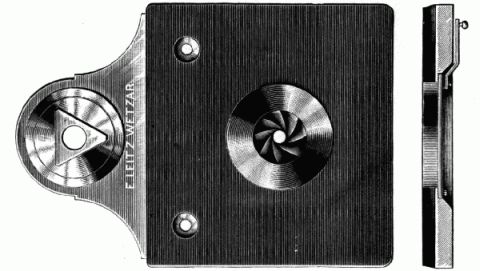
Stand III can be had with iris diaphragm fitted in stage, in place of the wheel diaphragm (see page 43) Additional price
$6.—
The outfits comprised in the following pages are made up with achromatic objectives, which suffice for all ordinary needs.
We are glad to supply any other combination of eye-pieces and objectives which may be preferred. The price of each outfit may be readily computed by adding together the cost of its various items.
Microscope stands, without objectives, will not be sold separately.
[24]
In the construction of our new stand "A" we have taken special care to enlarge all the parts proportionately in order to secure strength and stability, at the same time adding to the beauty of the instrument.
The upper pillar of the microscope is shaped in such a way as to form a convenient handle; and to increase the free working space over the stage, thereby allowing the examination of very large specimen and culture plates. A specially constructed mechanical stage larger than No. 98 may be attached, which is adapted for slides up to 2×4 inches (50×100 mm).
The extra large dimensions of all the main parts of this microscope such as the base and stage etc., allow that freedom of movement so desired in a stand for photo-micrography.
Both the body tube and graduated draw tube are very wide and permit the use of low power objectives to cover specimen of large extent; for the same reason the opening in the stage is very wide but can be narrowed down by a stop.
The most important innovation on the microscope is the new fine adjustment device, which is unexcelled both in solidity of construction and accuracy of movement, representing the highest attainment of the designers and mechanics skill.
Sectional cuts of this unique arrangement are shown in illustration (p. 26-27).
All that can be seen on the exterior are two small milled heads mounted below and somewhat back of the two larger knobs controlling the rack and pinion (coarse) adjustment of the microscope. The knob on the right side is provided with a graduated drum r, indicating the movement of the fine adjustment.
The two knobs with drum are mounted on an axle a, which in its central portion is enlarged and provided with a worm gear. The latter in its turn drives the gear wheel, d. A spiral spring pressing against one of the journals into which the axle is mounted prevents any lost motion in the worm gear. Mounted on the same shaft with the gear-wheel d, is a heartshaped cam f. On this cam rests the steel roller g, fitted on the support k, which in its turn carries[26] the microscope tube. By its weight and a spiral spring the latter presses on the cam f, and effects a direct vertical movement.

The periphery of the heart shaped cam f, is exactly symmetrical and mathematically correct. The distance traversed by its curved sides from the lowest to the highest point and vice versa is 3 mm. There are cut 60 teeth in the entire periphery of the gear-wheel d; the number corresponding to one side of the heart-shaped cam or 3 mm elevation, are 30 teeth, therefore 1 tooth means a movement of 3/30 mm or 0,1 mm.
This in turn requires one complete revolution of the axle a, the drum of which is graduated into 100 parts. The value of each division on the drum is therefore 0,1/100=0,001 mm.
This micrometer fine adjustment is exceedingly accurate and reliable, and besides it has the following advantages;
By virtue of its unique construction the movement is continuous, there is absolutely no limit to the motion of the micrometer screw, which may be turned forward or backward as the work requires.
This movement extends in exact ratio to the revolution of the cam for a distance of 3 mm. As another advantage we may mention, that it is almost impossible to break the coverglass of the specimen with this fine adjustment.
Should the objective come in contact with the coverglass and assuming the knob is turned still further then the tube, which is of aluminium and very light would simply rest on the specimen, without breaking the coverglass, as the latter will easily stand the small pressure of the tube and the fine spiral spring.

| No. 1. | New microscope stand "A" inclinable with hinged joint and clamping lever, fitted with round revolving centering stage, coarse adjustment by rack and pinion, new fine adjustment by micrometer-screw (each division 1/1000 mm.) Wide tube, draw tube with millimeter scale. Large illuminating apparatus with swing-out condenser and cylinder-iris diaphragm | $120.— |
Apochr. 16, 8, 4, oil-imm. 2 mm. N. A. 1,30 |
$204.— | |
Compens. ocular 4, 8, 12, 18 |
$34.50 | |
Compens. ocular No. 6 with micrometer and drawing ocular No. 93 |
$18.50 | |
Large mechanical stage No. 99, for object slides up to 2×4 inches |
$32.— | |
Triple nose-piece |
$8.— | |
| ——— | ||
Magnif. 70—2250. |
$417.— |
| No. 2. | The same stand and illum. apparatus; Object.: 2, 4, 6, oil-imm. 1/12, N. A. 1,30 Ocul. 0. I. III. IV. V. microm. ocul. II. Triple nosepiece |
$210.— |

| No. 3. | Large microscope, inclinable, with hinged joint and clamping lever and fitted with round revolving centering stage. Coarse adjustment by rack and pinion, new fine adjustment by micrometer-screw, the head of which is graduated each division = 1/1000 mm. Draw-tube with (see page 25-26) millimetre scale. Large illuminating apparatus with swing-out condenser and cylinder iris diaphragm (illustrated on page 21). | |
Mechanical stage, No. 98. Triple nose-piece. Drawing eye-piece, No. 93. Micrometer eye-piece, No. 84. Achromatic objectives Nos. 1, 3, 6. Oil-Immersion 1/12, N. A. 1,30. Eye-pieces 0, I, III, IV, V. Magnifications 12—1300 |
$236.— |
| No. 4. | The same stand and illuminating apparatus. | |
Triple nose-piece. Micrometer eye-piece, No. 84. Drawing eye-piece, No. 93. Objectives 2, 4, 6, Oil-Immersion 1/12, N. A. 1,30. Eye-pieces I, III, IV, V. Magnifications 33-1300 |
$210.— |
| The stand and illuminating apparatus without objectives, oculars and nose-piece | $112.— |

| No. 4a. | Large Microscope, of smaller size than Stand I, fitted with horseshoe foot. The stand is inclinable and fitted with revolving centering stage, coarse adjustment by rack and pinion, fine adjustment by micrometer screw with scale. Draw-tube with millimetre scale. Large Illuminating Apparatus (Cf. p. 22, b) with rack and pinion, and iris-diaphragm with oblique movement. The cylinder-diaphragm and condenser may be readily substituted for one another. | |
Triple nose-piece. Objectives 2, 4, 6, Oil-Immersion 1/12, N. A. 1,30. Eye-pieces I, III, IV, V. Magnifications 33-1300 |
$160.— |
| No. 4b. | The same with Illuminating Apparatus. | |
Triple nose-piece. Objectives 3, 6, Oil-Immersion 1/12, N. A. 1,30. Eye-pieces I, III, IV. Magnifications 60-1000 |
$148.— |
| No. 4c. | The same with Illuminating Apparatus. | |
Triple nose-piece. Objectives 3, 6, Oil-Immersion 1/10, N. A. 1,30. Eye-pieces II and IV. Magnifications 70-730 |
$136.— | |
| Stand with Illuminating Apparatus, but without objectives, eye-pieces and nose-piece | $76.— | |
| The same with Illuminating Apparatus, Swing-out Condenser and Cylinder Iris-diaphragm (p. 20, a) | $82.— | |
Mechanical stage No. 98 can be fitted to this
stand; price |
$28.— |

| No. 4d. | Large Microscope differing from the foregoing (Ia) stand only
in being provided with an English foot, which makes the stand
somewhat steadier and lighter. The prices and combinations are
otherwise the same. Dr. P. G. Unna of Hamburg uses this microscope in his laboratory. The stage revolves and centres. The illuminating apparatus is that described on p. 22, b. |
|
Triple nose-piece. Objectives 2, 4, 6, Oil-Immersion 1/12, N. A. 1,30. Eye-pieces I, III, IV, V. Magnifications 33—1300 |
$160.— |
| No. 4e. | The same with the illuminating apparatus. | |
Triple nose-piece. Objectives 3, 6, Oil-Immersion 1/12, N. A. 1,30. Eye-pieces I, III, IV. Magnifications 60—1000 |
$148.— |
| No. 4f. | The same with the illuminating apparatus. | |
Triple nose-piece. Objectives 3, 6, Oil-Immersion 1/10, N. A. 1,30. Eye-pieces II, IV. Magnifications 70—730 |
$136.— | |
| The stand with illuminating apparatus, but without objectives, oculars and nose-piece | $76.— | |
| The stand with swing-out condenser (p. 20, a) | $76.— | |
Mechanical stage No. 98 can be fitted to this
stand; price |
$28.— |

| No. 5. | Large Microscope, which differs from Ia only in the stage. The stage is fixed and square. The stand is inclinable and has a hinged joint and clamping lever. Draw-tube with millimetre scale. Coarse adjustment by rack and pinion, fine adjustment by micrometer screw with graduated head. Illuminating Apparatus, same as Ia (p. 22, b). | |
Triple nose-piece. Objectives 3, 6, Oil-Immersion 1/12, N. A. 1,30. Eye-pieces I, III, IV. Magnifications 60—1000 |
$142.— |
| No. 6. | The same with simplified Illuminating Apparatus (p. 22, c). | |
Triple nose-piece. Objectives 3, 6, Oil-Immersion 1/10, N. A. 1,30. Eye-pieces I, III, IV. Magnifications 60—730 |
$120.— |
| No. 7. | The same without Illuminating Apparatus, with Cylinder-diaphragm. | |
Double nose-piece. Objectives 3, 7. Eye-pieces I, III. Magnifications 60—450 |
$74.— |
| No. 8. | The same without Illuminating Apparatus and without nose-piece. | |
Objectives 3, 7. Eye-pieces I, III. Magnifications 60—450 |
$68.— | |
| Stand without objectives and eye-pieces, without illuminating apparatus and without nose-piece | $46.— | |
| Stand without objectives and eye-pieces, with illuminating apparatus, without nose-piece | $70.— | |
| The same with illuminating apparatus, with swing-out condenser and cylinder iris-diaphragm (p. 22 a) | $76.— |

| No. 9a. | Medium Size Microscope, inclinable, with revolving centering vulcanite stage, coarse adjustment by rack and pinion, fine adjustment by micrometer-screw. Draw-tube with millimetre scale. Illuminating apparatus and iris- diaphragm with lateral screw for raising and lowering. A ring under the iris diaphragm serves to hold a ground glass or colored disc. The illuminating apparatus and cylinder diaphragm are easily interchangeable. | |
Triple nose-piece. Objectives 3, 6, Oil-Immersion 1/12, N. A. 1,30. Eye-pieces I, III, IV. Magnifications 60—1000 |
$126.— |
| No. 9b. | The same with Illuminating Apparatus. | |
Triple nose-piece. Objectives 3, 6, Oil-Immersion 1/10, N. A. 1,30. Eye-pieces II, IV. Magnifications 70—730 |
$114.— |
| No. 9c. | The same without Illuminating Apparatus. | |
Triple nose-piece. Objectives 3, 6, 8. Eye-pieces I, III. Magnifications 60—550 |
$90.— |
| No. 9d. | The same without Illuminating Apparatus. | |
Double nose-piece. Objectives 3, 7. Eye-pieces I, III. Magnifications 60—450 |
$72.— |
| No. 9e. | The same without Illuminating Apparatus and nose-piece. | |
Objectives 3, 7. Eye-pieces I, III. Magnifications 60—450 |
$66.— | |
| Stand with Illuminating Apparatus and Iris-diaphragm, without objectives, eye-pieces and nose-piece. | $54.— | |
| The same stand with Cylinder Diaphragm | $44.— | |
| Stand with illuminating apparatus, swing-out condenser and cylinder iris diaphragm | $60.— | |
| Cylinder iris diaphragm (Cf. p. 23) | $6.— |

| No. 9. | Medium Size Microscope, inclinable, coarse adjustment by rack and pinion, fine adjustment by micrometer-screw. Draw-tube with millimetre scale. Illuminating apparatus and iris-diaphragm with lateral screw for raising and lowering. A ring under the iris diaphragm serves to hold a ground glass or colored disc. The illuminating apparatus and cylinder diaphragm are easily interchangeable. | |
Triple nose-piece. Objectives 3, 6, Oil-Immersion 1/12, N. A. 1,30. Eye-pieces I, III, IV. Magnifications 60—1000 |
$120.— |
| No. 10. | The same with Illuminating Apparatus. | |
Triple nose-piece. Objectives 3, 6, Oil-Immersion 1/10, N. A. 1,30. Eye-pieces II, IV. Magnifications 70—730 |
$108.— |
| No. 11. | The same without Illuminating-Apparatus. | |
Triple nose-piece. Objectives 3, 6, 8. Eye-pieces I, III. Magnifications 60—550 |
$84.— |
| No. 12. | The same without Illuminating Apparatus. | |
Double nose-piece. Objectives 3, 7. Eye-pieces I, III. Magnifications 60—450 |
$66.— |
| No. 13. | The same without Illuminating Apparatus and nose-piece. | |
Objectives 3, 7. Eye-pieces I, III. Magnifications 60—450 |
$60.— | |
| Stand with Illuminating Apparatus and Iris-diaphragm, without objectives, eye-pieces and nose-piece | $48.— | |
| The same stand with Cylinder Diaphragm | $38.— | |
| Cylinder iris-diaphragm (Cf. p. 23) | $6.— |

| No. 14a. | Medium Size Microscope, stand inclinable to the extent of 45°, tripod foot, coarse adjustment by rack and pinion, fine adjustment by micrometer screw. Draw-tube with millimetre scale. Illuminating Apparatus and Iris-diaphragm permanently connected and sliding in a sleeve underneath the stage. The cylinder-diaphragm is used in the same manner. A ring below the iris-diaphragm serves to hold a ground glass or colored disc. | |
Triple nose-piece. Objectives 3, 6, Oil-Immersion 1/12, N. A. 1,30. Eye-pieces I, III, IV. Magnifications 60—1000 |
$104.— |
| No. 14b. | The same with Illuminating Apparatus. | |
Triple nose-piece. Objectives 3, 6, 8. Eye-pieces II, IV. Magnifications 70—700 |
$78.— |
| No. 15a. | The same without Illuminating Apparatus. | |
Double nose-piece. Objectives 3, 7. Eye-pieces I, III. Magnifications 60—450 |
$50.— |
| No. 15b. | The same without Illuminating Apparatus and nose-piece. | |
Objectives 3, 7. Eye-pieces I, III. Magnifications 85—450 |
$44.— | |
| Stand with Illuminating Apparatus and Iris-diaphragm | $32.— | |
| Stand with Cylinder or Wheel-diaphragm | $22.— | |
| Cylinder iris-diaphragm (p. 23) | $6.— | |
| For the addition to this microscope of a lateral screw for raising and lowering the illuminating apparatus as on Stand IIa, an extra charge of $2.— is made. |

Stand III is now provided with rack and pinion coarse adjustment instead of sliding tube. In consequence a nose-piece can be used on it to better advantage. It will be found an excellent laboratory stand at low price.
| No. 16a. | Medium Size Microscope, non-inclinable stand, coarse adjustment by rack and pinion, fine adjustment by micrometer-screw. The draw-tube has a millimetre scale. Plane and concave mirror. Wheel-diaphragm. | |
Triple nose-piece. Objectives 3, 6, 8. Eye-pieces I, III. Magnifications 60—550 |
$66.— |
| No. 16b. | The same without nose-piece. | |
Objectives 3, 6, 8. Eye-pieces I, III. Magnifications 60—550 |
$58.— |
| No. 17a. | The same, with double nose-piece. | |
Objectives 3, 7. Eye-pieces I, III. Magnifications 60—450 |
$48.— |
| No. 17b. | The same without nose-piece. | |
Objectives 3, 7. Eye-pieces I, III. Magnifications 60—450 |
$42.— | |
| Stand with wheel-diaphragm | $20.— | |
| This stand can be supplied with iris diaphragm in stage (see illustration p. 23) instead of wheel-diaphragm. | ||
| Stand with iris diaphragm | $26.— |

The dimensions of this stand are now larger than formerly. The price has not been changed.
| No. 18. | Small Microscope. Adjustable by sliding tube and micrometer-screw. The draw-tube is graduated in millimeters. Cylinder-diaphragm with sliding sleeve. Concave and plane mirrors, obliquely adjustable. | |
Objectives 3, 6, 8. Eye-pieces I, III. Magnifications 60—550 |
$52.— |
| No. 19. | The same. | |
Objectives 3, 7. Eye-pieces I, III. Magnifications 60-450 |
$36.— |
| No. 20. | The same without Cylinder Diaphragm, with Wheel Diaphragm. | |
Objectives 3, 5, 7. Eye-pieces I, III. Magnifications 60—450 |
$44.— |
| No. 21. | The same. | |
Objectives 1, 3, 7. Eye-pieces I, III. Magnifications 18—450 |
$40.— |
| No. 22. | The same. | |
Objectives 3, 7. Eye-pieces I, III. Magnifications 60—450 |
$34.— | |
| Stand with cylinder-diaphragm, without objectives and eye-pieces | $14.— | |
| Stand with wheel-diaphragm, without objectives and eye-pieces | $12.— |

| No. 23. | Small Microscope. Adjustable by sliding tube and micrometer-screw. Concave mirror. | |
Objectives 3, 7. Eye-pieces I, III. Magnifications 60—450 |
$30.— |
| No. 24. | The same. | |
Objectives 3, 5. Eye-pieces I, III. Magnifications 60—250 |
$28.— |
| No. 25. | The same. Plane mirror. | |
Objectives 1, 3. Eye-pieces I, III. Magnifications 18—80 |
$24.— |
| No. 26. | The same. | |
Objectives 3. Eye-pieces I, IV. Magnifications 60—105 |
$18.— |
| No. 27. | Stand without objectives and eye-pieces | $8.— |

| No. 28. | Auxiliary Laboratory Stand, for the examination of
trichinae and for searching plate cultures. Very large
stage (3-1/2×4 inch.). Adjustable by means of a carefully
constructed rack and pinion, rendering it possible to
focus objectives of fairly high power. Stand, without eye-pieces, objectives or case |
$8.— |
| No. 29. | This stand fitted with objective 3, eye-pieces 0 and IV. Magnifications 40 to 100, in mahogany case fitted with lock | $18.— |
| No. 29a. | The same stand fitted with eye-piece II and objective having separable front lens, yielding a magnification of 40 and 100 diam | $18.— |
| Glass compressor with graduation | $80.— | |
| Glass compressor without graduation, per pair | $40.— |

| No. 30a. | Adapted for low and medium power. Square stage with wheel-diaphragm. Adjustment by sliding tube; after being adjusted the tube may be fixed by a ring clamp. Detachable handle. With clip to hold a sketch or label, etc. Stand without objective and eye-piece. |
$6.— |
| No. 30b. | The same with objective 3 and eye-piece I, magnifying 60 times | $14.— |
| No. 30c. | The same with adjusting screw for focussing high power objectives, with condenser and iris-diaphragm, without objectives and eye-pieces | $18.— |
| No. 30d. | The same with objectives 3 and 6 and eye-piece I. Magnifications 60 and 255 | $38.— |

| No. 31. | The sliding microscope is an instrument by means of
which very large microscope sections, as, for example,
large sections of the brain, can be systematically
examined. It is also of service in looking over plate
cultures of bacteria. The microscope is carried on a heavy beam supported by two stout pillars under which the stage moves. The various movements are accomplished by motion of the microscope on a lateral track upon its support and by motion of the stage on a similar track at right angles to the first. The motion of the microscope is by means of a screw, that of the stage by double rack and pinion. The extent of the movements is indicated in each case by a scale, thus permitting the systematic examination of the entire specimen. The stage consists of a glass plate, measuring 16×20 cm, which is carried in a frame supported on four columns. The tracks permit a motion of the microscope of 18 cm and of the stage of 13,5 cm. A mirror under the stage affords ample illumination. The microscope tube is so arranged that it can be easily removed from the stand and a simple lens substituted for it. The coarse adjustment of the microscope is by rack and pinion. A screw above the objective serves for fine adjustment. The price of this sliding microscope, without objectives or oculars, but with a lens holder and simple lens magnifying eight diameters is |
$80.— |
| Flat glass dish of the same size as the stage to hold very large sections for the purpose of examining them while in clearing fluid | $1.25 |

| No. 32. | Dölken's Stand. (p. 52) The stand is larger than Stand No. Ia, but is modified as shown in the cut so as to permit the examination of unusually large preparations. It is provided with the illuminating apparatus b (p. 22) and with all the adjustments necessary to the use of high powers. | |
| Stand and illuminating apparatus, without nose-piece | $80.— |

| No. 33. | Travelling Microscope. This microscope is
ready for use after spreading the foot, drawing out the tube and
setting the mirror and stage in position. It is provided with all
the adjustments of Stand No. V, consisting of fine adjustment by
micrometer-screw, coarse adjustment by rack and pinion and
illuminating apparatus d (p. 22). The box is arranged so as to
accommodate three objectives and two oculars. It locks, has a handle,
and measures 25×15×7 cm, the whole apparatus weighing 5 pounds. Price of this microscope with illuminating apparatus, but without objectives or oculars |
$32.— |
| The same, without illuminating apparatus | $24.— |

This instrument (in size like the Ib.) combines all the essential features of a large laboratory microscope with a folding stand. It will be found invaluable on scientific expeditions, for research work etc.
When lifted out of the case, spread the two parts forming the base, which are then held by a spring-catch. After raising the tube, turn the stage around and tighten it by means of a lever. It is supplied with large Abbe condenser and Iris diaphragm adjustable by side screw. Coarse adjustment by rack and pinion, fine adjustment by micrometer-screw. Graduated draw-tube. The stand has joint for inclination.
[55]
| No. 34. | Stand with Abbe Condenser and Iris-Diaphragm, double nose-piece | $66.— |
| No. 35. | The same, with objectives 3, 6, Oil-Immersion 1/12", N. A. 1,30. Eye-pieces I, III. Magnifications 60—800 | $128.— |

| No. 36. | Horizontal Microscope. This instrument consists of a microscope tube
placed horizontally on a long extensible column, supported in turn by a
tripod base provided with levelling screws and a round spirit level. The
extension of the upright supporting column is accomplished by two
sliding motions, the lower, controlled by a set screw only, being
intended for coarser adjustments, the upper, controlled by rack and
pinion, for finer adjustments. A millimeter scale and a vernier serve to
indicate the degrees of the various motions, so that vertical motion of
the microscope tube to the extent of 1/10 mm may be accomplished. The microscope tube carries a spirit level and revolves upon a horizontal disc. The objective, consisting of two separable doublets, permits three degrees of magnification of 5, 9 and 48 cm focal distance respectively. A rack and pinion adjustment serves as adjustment of the microscope tube. A micrometer, 1 cm long and divided into 100, in the diaphragm of the ocular still further increases the availability of the instrument for making fine and accurate measurements. The instrument serves as a useful aid in many physical and physiological investigations. Price, including objective, ocular and micrometer |
$40.— |
We construct two Microscopes for mineralogical investigations. Both are adapted for determining the axes of elasticity and for the differentiation of isotropic and anisotropic bodies. Stand I alone is adapted for determining the optical axes and their angles.
Only such objectives, condensers and oculars are available for mineralogical examinations as have been shown after careful examination in polarized light to be free from polarization.

| No. 37. | This microscope corresponds in its dimensions to Stand Ia as
described on page 31. Coarse adjustment by rack and pinion,
fine adjustment by micrometer-screw, the milled head of which
has 50 divisions, each representing a motion of the objective
of 1/100 mm. The condenser, iris-diaphragm and polarizer can
be raised and lowered by rack and pinion. A triple condenser
facilitates the observation of the axial lines in the microscope.
It is so arranged as to be easily replaced by a simple diaphragm-carrier.
By means of a collar attached to the end of
the tube the objective is brought into coincidence with the
centre of the revolving stage. This revolving stage is divided
into 360 degrees and fitted with a vernier and index.
Two scales on the stage, at right angles to each other,
permit accurate location of specimens. The Nicol prism,
which serves as a polarizer, can, after turning the iris-diaphragm
aside, be drawn out from under the latter.
The zero position of the Nicol prism is indicated by a
line, as well as the angles 90, 180, 270°. The analyser
is mounted in metal and is firmly fixed above the
eye-piece. The analyser rotates on a disc graduated to
360 deg. The front of the tube has a movable window
which provides access to the inner tube. In the latter
is an opening for the introduction of a Bertrand lens.
This lens serves the purpose of magnifying the interference
figures produced by the converging rays of
polarized light. This lens and the eye-piece can be
raised or lowered by rack and pinion. In the analyzer
is a slide for the insertion of gypsum and quartz plates
at an angle of 45 degrees. In many investigations it is advisable to employ an analyzer introduced laterally into the tube, instead of the one mentioned above. The following parts are supplied to complete the outfit: |
|
Triple nose-piece. Eye-piece 0, with Bertrand's quartered quartz plate. Eye-piece I with cross-lines, Brezina's Calcspath-plate, cleft perpendicularly to its axis, made to fit over eye-piece I, Klein's gypsum and quartz plates for insertion in the opening over the objective. Price of the stand with these accessories |
$160.— |
| No. 38. | The same with eye-piece III, objectives 1, 3, 5, 7. 1/12 Oil-Immersion, magnifications 18—800 | $236.— |
| The new mechanical stage No. 98 (See page 78) can be
fitted to the stand for the purpose of investigating
large preparations and serial sections.
Price |
$28.— |

| No. 39. | The base and pillar are in one piece, neatly japanned
black. The coarse adjustment is by rack and pinion. The stage is revolving and graduated on the edge into 360 degrees. A pointer indicates its position. The polarizer has stop at zeropoint and also marks at 90°, 180° and 270°. It is held in a spring-sleeve and the substage can be raised and lowered by lateral screw, or may be swung to one side. The condenser is mounted in separate arm above the polarizer and swings out of the optical axis by means of a lever, if parallel instead of convergent rays are desired. The analyzer fits into an opening of the tube above the objectives and can be instantly thrown in or out of the optical axis. There is a slot below the analyzer for the insertion of quartz and gypsum plates. By means of a collar with two centering screws attached to the end of the tube, the objective may be brought into the optical axis. Price of this microscope with eye-piece I with cross-lines, Klein's quartz wedge and gypsum plate, red, I. order |
$56.— |
| No. 40. | The same with eye-piece III. and objectives 3 and 5. Magnifications 60-250 | $74.— |

| No. 41. | Large Dissecting Microscope.
Stand on heavy horse-shoe base, large stage with glass plate, adjustment by rack and pinion. The lens-carrier is movable for examining large plates. Illumination by movable plane mirror and white glass plate. Metal hand-rests covered with leather may be attached to the sides of the stage. They fit inside the mahogany case. A black metal plate with wheel-diaphragm or a milk-glass-plate can be inserted below the stage, serving as dark or white back-ground respectively. Stand without lenses in mahogany case |
$16.— |
| No. 42. | The same with three aplanatic lenses after Steinheil, magnifying 8, 16 and 20 diameters | $28.— |
| No. 43. | The same with these lenses and Abbe's drawing apparatus | $40.— |
| No. 44. | The same stand with prism-tube No. 49 for erected image. Objectives 1*, 2, 3, magnifying 18, 40 and 80 diam. | $47.25 |

| No. 45. | Simple Dissecting Microscope, with adjustment by rack and pinion, movable plane mirror and white glass plate, glass stage in metal frame. Metal hand-rests covered with leather fit inside the case. Stand without lenses | $8.— |
| No. 46. | The same with two aplanatic lenses after Steinheil, Magnification 10 and 20 diam. | $16.— |
| No. 47. | The same stand with prism-tube No. 49, for erected image; with objectives 2 and 3, magnifying 40 and 80 diam. | $36.— |

The Dissecting microscope with erected image according to Prof. R. Pfeiffer has been constructed in such a way that all parts extending on both sides can be folded or turned, so that the instrument fits in a very small case.
The base consists of two parts which may be folded. The stage can be brought in a position vertical to the optical axis and the metal hand rests laid on top of the stage. They are connected with the latter by joints. The mirror can also be turned and put parallel to the pillar.
A round glassplate is set in the stage, below which is an iris diaphragm to properly regulate the illumination.
The adjustment is by rack and pinion.
Two rightangle prisms are mounted inside the tube in such a manner that the image obtained by the objective is reflected into the eye-piece and appears erected.
The eye-piece is of the Ramsden form. Three objectives of different magnifying power with specially long working-distances have been constructed Nos. 1, 2, 3.[65]
The following table shows the magnification of the objectives in connection with the eye-piece.
| Objective | 1 | 2 | 3 |
| Magnification | 18 | 40 | 80 diam. |
| Working distance | 58 mm | 18 mm | 6 mm |
| No. 48. | Folding dissecting microscope, stand only | $24.— |
| No. 49. | Upper part of the microscope, consisting of tube with prisms, and one eye-piece | $16.— |
| No. 50. | Objectives 1, 2, 3, a $ 6,00 | $18.— |
| ——— |
| No. 51. | Stand with complete outfit | $58.— |
The instrument is furnished in a mahogany case with nickelplated handle, lock and key.

| No. 52. | Lens-holder on iron foot with moveable arms, the joints of which may be fixed by thumb-screws, rack and pinion adjustment—without lens | $7.20 |
| No. 53. | Lens-holder, nickel-plated stand with attachment of the collar holding the lens by ball and socket joint | $4.— |
| No. 54. | Lens-holder on heavy iron foot, ball and socket joints, adjustable to any position—without lens | $3.25 |
| No. 55. | Pocket microscope. The size of an eye-piece, in box | $3.25 |
| No. 56. | Lens for examining Algae | $1.25 |
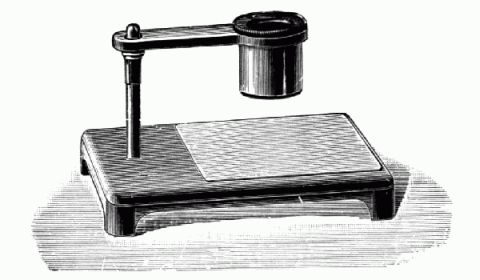
| No. 57. | Dissecting Stage with white glass plate and moveable lens-holder—without lens | $2.— |
| No. 58. | The same with lens No. 71 | $3.25 |
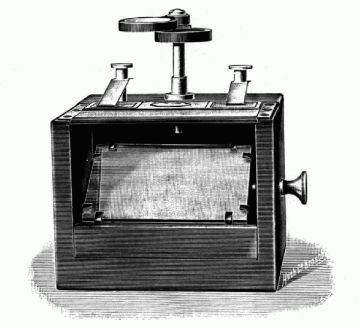
| No. 58a. | Simple Dissecting Microscope, consisting of a wood case with plate glass stage, movable plane mirror, two simple lenses of 4 and 8 times magnification. Price | $2.— |
| No. 58b. | The same with metal hand rests, moveable lens-holder and doublet magnifier No. 71, Price | $3.50 |
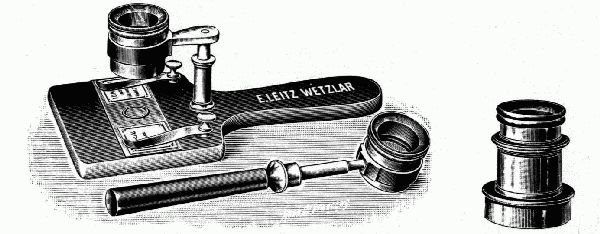
| No. 59. | Demonstration lens-holder, consisting of a hardrubber stage with handle, clamps for holding the preparation in position, and with a moveable lens-holder. Without lens | $2.40 |
| No. 60. | Focussing lens for photographic camera. Lens in spring-sleeve with clamping ring | $4.75 |
| No. 61. | Handle with ring for holding lens | $1.25 |
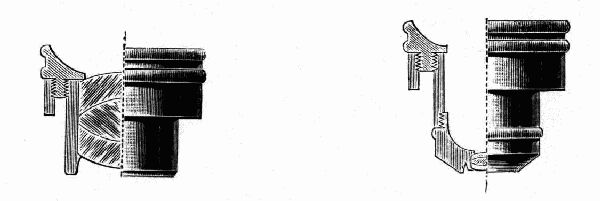
The aplanatic triplets after Steinheil are remarkable for their large, flat field and excellent definition, free from chromatic aberration.
| Diameter Visual field Magnification | ||
| No. 62. | 24 mm 20 mm 8 diam. | $4.— |
| No. 63. | 15 " 15 " 10 " | $4.— |
| No. 64. | 12 " 12 " 12 " | $4.— |
| No. 65. | 10 " 10 " 16 " | $4.— |
| No. 66. | 6 " 3,5 " 20 " | $4.— |
| No. 67. | 5 " 2 " 30 " | $4.— |
| No. 68. | 3 " 1 " 40 " | $4.— |
The achromatic doublets have a very large, clear and flat field.
| No. 69. | 30 mm 35 mm 5 diam. | $4.— |
| No. 70. | 23 " 20 " 8 " | $3.25 |
Doublet magnifier, consisting of two double convex lenses.
| No. 71. | 23 mm 25 mm 6 diam. | $1.25 |
The doublet No. 69 can only be used as a hand lens. The mounting of all the other lenses is such that they fit any of the dissecting stands or lens holders. Aplanatic triplets 64-68 can only be used on stands with rack and pinion adjustment.

| No. 72. | The aplanatic lenses Nos. 62-66 are also to be had
with a moveable cover and ring adapting them for use as pocket lenses.
Price, when thus mounted |
$4.75 |
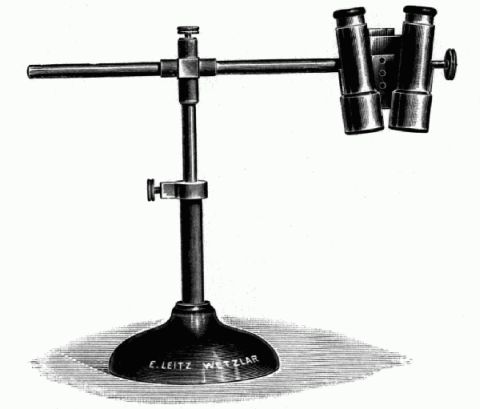
| No. 73. | The Binocular Preparation Microscope, after the model
of Eilhard Schulze permits the convenient use of both
eyes in dissecting small anatomical and botanical preparations.
It consists of two Brücke lenses, adjusted to an accurate focus. Both tubes are moveable on a joint and are adjustable to various distances between the observers eyes. The distance of the eye from the preparation is about 250 millimetres; the field of vision is large and flat; the magnification, four diameters; lenses are adjustable to either vertical or horizontal position and may be raised and lowered on the vertical support, thumb-screws fixing them in the desired position. A rack and pinion serves as fine adjustment |
$24.— |

| No. 74. | Greenough's Stereoscopic Binocular Microscope. Two
microscope tubes are so arranged as to bring the same object into
focus in the axis of each tube, the tubes being set at an angle
to each other for this purpose. The stand is provided with rack
and pinion adjustment and both draw-tubes are also regulated by a
rack and pinion arrangement, so that they may be adapted to the
correct distance of the observers eyes. By interposition of prisms the image is rendered erect. Magnification, 20 diam. Price |
$80.— |
| No. 74a. | Corneal-Microscope, is designed for the examination of
the interior of the eye. Prismtube No. 49 with eye-piece |
$16.— |
| Objective of low power permitting 2 degrees of magnification | $6.— | |
| Stand on heavy base, with rack and pinion adjustment etc. | $8.— | |
| ——— | ||
| $30.— |

| No. 75. | The Micro-Spectroscope fits into the tube of the microscope like any ordinary eye-piece and may be fixed in any desired position by means of the thumb-screw M. The position of the bright and dark lines of the spectrum and their respective wave lengths are ascertained by means of a scale. The flat drum A, the interior of which is shown in section, contains the slit and the comparison prism. The slit is regulated by the screws F and H. The lever T moves the comparison prism across one half of the slit. The cylinder Q above the eye-piece contains the Amici prism. At the point N of the horizontal tube RN is the micrometer scale, illuminated by the mirror O. After raising the spring-catch L the upper part of the spectroscope may be turned round the pivot K, thus allowing of the adjustment of the eye-piece | $66.— |
| No. 76. | Hand-Spectroscope, Browning's, for spectroscopic examination of the blood | $12.— |
| No. 76a. | Hand-Spectroscope with comparison prism, mirror, and holder for vials | $16.— |

| No. 77. | Thoma's Haemacytometer consists of an object glass
with carefully constructed cell, a ground absolutely
plane coverglass and two pipettes for mixing the blood
and saline solution used in the examinations. One of
these pipettes, for estimating the number of red corpuscles
is so graduated as to permit dilution of the blood
100 or 200 times as required; the other, for counting
the white corpuscles (leucocytes), is graduated for
dilution of the blood 10 or 20 times. The volume contents of the pipettes are most carefully determined and the depth of the cell is established by accurate micrometric measurement, thus permitting very exact observations by means of this instrument. (A full description with each instrument) |
$12.— |
| No. 78. | Mixing-Pipette for white corpuscles | $3.60 |
| No. 79. | Mixing-Pipette for red corpuscles | $3.60 |
| No. 80. | Thoma counting chamber, with coverglass | $5.75 |
| No. 81. | Türck counting chamber with coverglass | $7.25 |
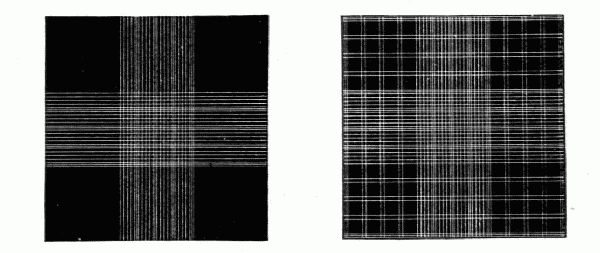
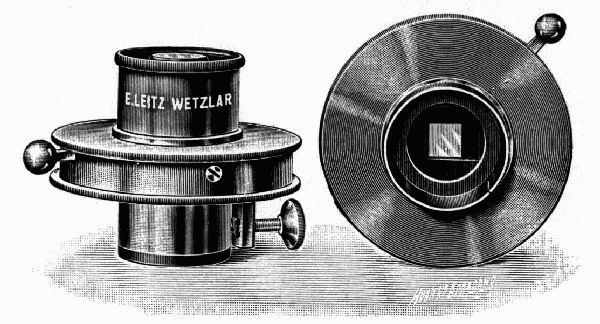
| No. 82. | Ehrlich's Eye-piece is provided with a diaphragm having
a square opening, the size of which is regulated by a
small lever. This eye-piece is designed to facilitate the estimation of the relative numbers of red and white blood corpuscles in dry preparations. Full directions accompany each instrument |
$12.— |
| No. 82a. | Apparatus for the clinical determination of the alcalinity
of the blood, after Prof. C. S. Engel. The following parts compose the apparatus: 1) a capillary pipette so graduated as to permit the dilution of 0,05 cc. blood from the finger, up to 5 cc. with distilled water. 2) a beaker, for the reception of the diluted blood. 3) a burette mounted on stand, capacity 10 cc. Full directions accompany each outfit. Price in box |
$8.— |

| No. 83. | Screw-micrometer eye-piece for accurate measurement of large objects. Between the eye lens and the collecting lens of a Huyghenian ocular there is a millimeter scale etched on glass, above which is a moveable indicator whose position is controlled by a micrometer screw to which a graduated drum is attached. The value of each graduation on the drum (about 1/20 of the micrometer value of the objective) must be determined for each combination of ocular and objective by means of the stage micrometer. The eye lens of the ocular is moveable to permit accurate focus upon the scale. The apparatus slips into the tube of the microscope like any ordinary eye-piece and is fixed in position by a thumb-screw at the side | $20.— |
| No. 84. | Micrometer eye-piece. The mount unscrews in the centre to permit the introduction of the micrometer scale. The eye lens is moveable to permit of accurate focus on the scale | $4.— |
| No. 85. | Glass-Micrometer for the eye-piece, to drop on the diaphragm of the eye-piece. Scale of 5 mm divided into 100 parts | $2.50 |
| No. 86. | The same, 10 mm divided into 100 parts | $2.— |
| No. 87. | Stage-Micrometer, 1 mm divided into 100 parts etched on glass | $3.75 |
| No. 88. | Stage-Micrometer, photographed on glass, 2 mm divided into 200 parts | $1.40 |
| No. 89. | Eye-piece Micrometer, divided into squares for counting scattered objects in the field. Mounted. Distance between the lines 0,5 mm | $2.— |
| No. 90. | Glass slide with cell 2/10 mm deep, with ocular micrometer No. 89, in box | $3.25 |
| No. 91. | Glass slide with cell the floor of which is divided into squares, 1/400 square mm each, in box | $4.— |

| No. 92. | This drawing eye-piece is employed with the stand in the vertical position. The reflected image lies at the side of the microscope, the rays passing off at an acute angle from the reflecting prism near the top of the eye-piece. The eye-piece slips into the tube of the microscope like any ordinary eye-piece and is held in position by a thumb-screw. The drawing field is at once visible without further adjustment, and the picture is clear and sharp. The brightness of the drawing field may be regulated by smoked glass plates mounted in two moveable metal arms | $8.— |

| No. 93. | This drawing eye-piece is similar in construction to that just described, but is so arranged as to throw the image vertically downwards behind the microscope when the latter is inclined at an angle of 45 degrees. In this case also the picture reflected is clear and sharp, devoid of all disturbing secondary images. As the image is reflected vertically downwards upon the table, no special drawing stand is necessary as there is no distortion of the picture. The intensity of the light may be modified by smoked glass plates mounted in two moveable metal arms | $10.— |
For a description of these drawing eye-pieces and of the principles involved in their construction reference may be had to the Zeitschrift für wissenschaftliche Mikroskopie, XII, 1895.
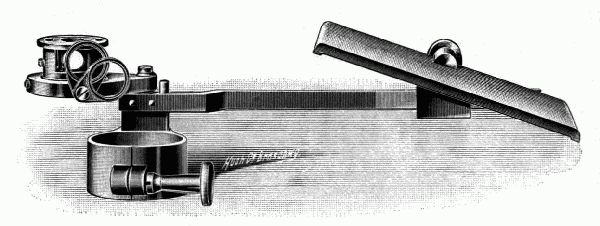
| No. 94. | In Abbe's Drawing Apparatus the drawing field is reflected by a mirror at the side of the instrument and by a prism which fits over the eye-piece of the microscope. The prism is supported on a vertical hinge so that it may be readily turned out of the axis of the microscope without disconnecting the whole apparatus from the stand. It is shown turned to the side in the figure. A cylindrical cap accompanies the apparatus which fits over the prism holder and has six lateral windows in which are smoked glasses of various intensity, serving to regulate the lightness of the reflected drawing field | $12.— |
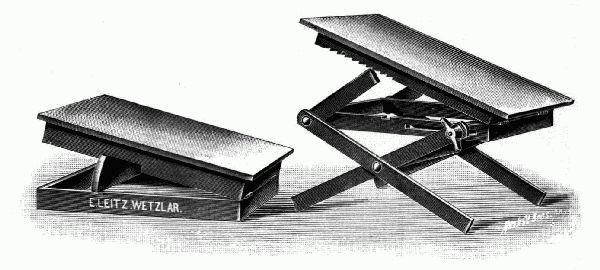
The Drawing boards serve two purposes. They afford a smooth plane surface for the drawing paper and they are so arranged that they may be inclined at such an angle as to receive the rays of the reflected[77] image at right angle to their surface, thus doing away with any distortion of the image on the paper.
| No. 95. | This drawing board is especially adapted for use with drawing eye-piece No. 92. When in the position indicated in the figure its drawing surface forms an angle of 12° to the horizontal | $2.— |
| No. 96. | In Giesenhagen's drawing board the drawing surface may be adjusted at various angles and may be raised and lowered | $4.— |
For drawing eye-piece No. 93 and the Abbe drawing apparatus the surface of the drawing board should be horizontal.

| No. 97. | The drawing apparatus after v. Tubeuf serves for drawing objects from nature. By means of a prism mounted in a metal box, the object is reflected into the eye in such a manner that its image appears erected on the drawing surface. This is quite an advantage when drawing from nature but is unimportant when using a drawing apparatus on the microscope. Two smoked glasses mounted in moveable metal arms serve to moderate the intensity of the light. On the side of the prism nearest the eye is a small wheel diaphragm attached to regulate the size of the opening. The apparatus is mounted on a heavy nickel-plated stand with vertical and lateral adjustments controlled by thumb-screws | $12.— |

| No. 98. | Mechanical stage adapted to Stands I, Ia and Ib. The stage is
readily attached to the microscope by means of a small screw,
C, which screws into a thread in the microscope just behind its
stage, and binds the mechanical stage firmly in position and
always in the same position. It may be again removed by simply
unscrewing this set screw. The movements of the stage are at right angles to one another, are accomplished by carefully constructed rack and pinion adjustments and the exact position of each adjustment is indicated by vernier scales. The extent of the lateral movement is 50 mm; that of the other 30 mm. This stage permits the careful and systematic examination of large specimens and its construction is so perfect that by means of the vernier scales the most minute objects may be readily replaced in the field of vision, even after removal and readjustment of the stage, provided only that their location when in the field of vision as indicated by the scales had been noted |
$28.— |
| No. 99. | Large mechanical stage for stand, A, adapted for slides 50×100 mm; both movements by rack and pinion adjustments | $32.— |
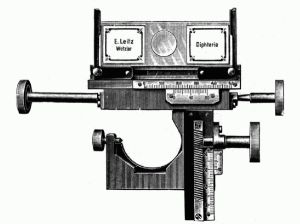
| No. 100. | Mechanical Stage No. 100. When a mechanical stage is ordered subsequently to a microscope outfit and under such circumstances that its correct adjustment to the stand by a skillful mechanic is impossible we advise the purchase of this more readily adjusted mechanical stage, which may readily be attached to Stands I, Ia, Ib, IIa and IIb by means of a thumb-screw. It is as carefully constructed as Mechanical Stage No. 98 and serves the same purpose in every particular | $28.— |
| No. 100a. | New Mechanical stage, simplified form | $20.— |
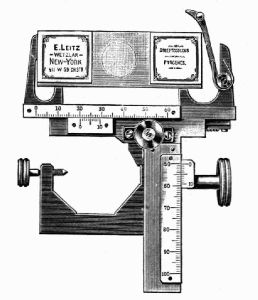
| No. 101. | Warm stage after Schultze. This consists of a metal stage to which long lateral arms are attached, through which the heat from one or more small lamps is conducted to the central part of the stage and the object. The apparatus is also provided with a condenser, which affords illumination sufficient for the use of high power objectives, and with a thermometer indicating the exact temperature of the centre of the stage, which may be carried as high as 100° C. | $12.— |
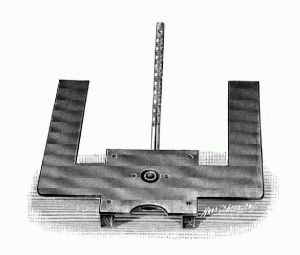
| No. 102. | Warm stage after Pfeiffer. It consists of a glass chamber through which warm water may be made to flow. A small cell is ground in its surface thus permitting its use as a moist chamber | $6.— |
| No. 103. | Warm stage after Stricker. This stage consists of a metal chamber, through which warm water is made to flow when in use, and is provided also with a condenser and thermometer. It may be screwed firmly to any of the square microscope stages | $14.— |
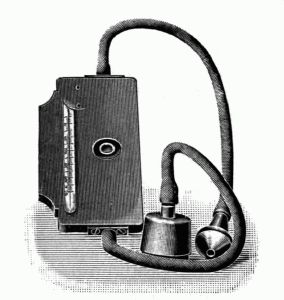
| No. 104. | Warm stage after Errera, permitting rapid changes from low
to high temperature and vice-versa. It includes 2 vessels for cold and hot water, mounted on tripods, with rubber-tubing etc. |
$24.— |
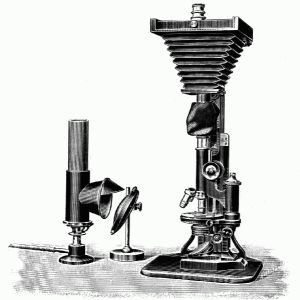
The method of employing this apparatus and the general technique of photo-micrography are treated of in a separate pamphlet containing also four photo-micrographs taken with this apparatus.
This little work is furnished with each apparatus.
| No. 105. | The Photo-micrographic Apparatus consists of a heavy iron
foot supporting a stout column in which another iron support
moves vertically. This latter holds the camera and may be firmly
fixed at any height by means of a thumb-screw. This permits the
accurate adjustment of the camera to microscope stands of various
sizes. The length of the camera is also adjustable by means of a
thumb-screw sliding in the upright support. Regulation of the
field of the camera is accomplished by a revolving disc diaphragm
with openings of five different sizes situated in the neck of the
camera. Two simple plate-holders for plates 9×12 and 13×18 cm are
supplied with each camera, as are also a ground glass plate and
clear glass plate in the frame of the camera serve to catch the
picture in the plane of the photographic plate, and a simple lens
aids in obtaining a correct focus of the image. A white glass
plate, mounted on a stand is of use in diffusing direct sunlight
so as to make it available for photographic purposes, and three
discs of yellow, blue and green glass are provided which may be
inserted over the iris-diaphragm of the condenser when colored
light is required. It is of great advantage to interpose an illuminating lens between the source of light and the mirror, thereby condensing the light-rays, giving a uniform illumination and preventing the heating up of the entire stand, which is a disturbing factor in retaining the focus. The illuminating lens also serves to lessen the time of exposure. This photo-micrographic apparatus is also available when it is desired to photograph gross specimens as, for example, embryos, insects, etc., by reflected light, as is represented in the figure on p. 86. The photographic objective of 64 mm focal distance, is best adapted to this purpose. It fits in a collar in the neck of the camera and yields a magnified image of about 3 diameters. The object is brought into proper focus by means of a small stand, the table of which may be raised or lowered as required. Price of the apparatus without microscope stand |
$40.— |
| No. 106. | Small stand for supporting specimens to be photographed by reflected light as mentioned above | $4.75 |
| No. 107. | Welsbach lamp with reflector | $6.— |
| No. 108. | Illuminating lens of 100 mm diam. on stand | $12.— |
| No. 109. | Photo-micrographic apparatus, for use in horizontal and
vertical position. It is in construction similar to the
foregoing, but is provided with joint for inclination and
clamping lever, and can be used at any angle. Large size bellows and plateholder, for plates up to 24×24 cm. Moveable platform with three leveling screws and clamping-bar for holding stand. Price of the apparatus, with 2 simple plate-holders, ground and plain glass plate, etc., without microscope stand |
$60.— |


| No. 110. | Edinger's Projection Apparatus—For projecting and drawing
large objects slightly magnified. (Cf. Zeitschrift für wissensch.
Mikroskopie. VIII. 1891.) A polished wooden base, in which a lime wood drawing tablet is inlaid, supports a wooden stand which in turn holds a horizontal metal tube in which are a collecting lens and a reflecting mirror. The upright also carries, two arms, by rack and pinion adjustment, the one supporting the object stage, the other regulating the length of the camera. On the other side of the upright is a support for a lamp. The rays of this lamp are converged by the collecting lens upon the mirror, are reflected downward to the object and through the objective to the drawing board below. The various adjustments permit considerable variation of magnification with the same objective. Price, including lamp |
$18.— |
For photographic purposes this same apparatus may be had with Nieser's photographic camera, plate holders, focussing plate etc.
| No. 111. | Edinger's Projection Apparatus with Camera for plates 9×12 cm and 13×18 cm | $38.— |
| No. 112. | Larger Projection Apparatus with Camera for plates 9×12, 13×18, 18×24 and 24×30 cm | $56.— |
The following Objectives of 24, 35, 42 and 64 mm focal distance respectively may be used in connection with this apparatus for photographic purposes.
| No. 113. | } { of 24 mm focal distance | $18.— |
| No. 114. | } Photographic Objectives { " 35 " " " | $18.— |
| No. 115. | } with Iris diaphragms { " 42 " " " | $18.— |
| No. 116. | } { " 64 " " " | $20.— |
The following table shows the size of the preparation which may be resolved by each one of these objectives and the magnification with the smaller and with the larger Edinger Projection Apparatus.
| Objective Focal length |
Size of the Preparation Maximum |
Magnification Smaller Apparatus |
Magnification Larger Apparatus |
| 24 mm | 8 mm | 7-15 diam. | 13-25 diam. |
| 35 mm | 15 mm | 5-12 diam. | 10-20 diam. |
| 42 mm | 20 mm | 3-9 diam. | 6-13 diam. |
| 64 mm | 35 mm | 2-4 diam. | 3-8 diam. |
The time required for exposure in photographing with this apparatus is from 5 to 20 seconds according to the magnification and character of the specimen.
The following figure shows a further use for the Objective of 64 mm focal distance in connection with the photomicrographic apparatus (page 82).

In this projection apparatus an electric projection lamp is made use of, the lamp being available for electric currents of 20 Ampères and about 48 Volts. To regulate the current a rheostat is necessary. When using constant current the carbons should stand at an angle in order to utilize to best advantage the stronger light of the positive (upper) carbon. For spectroscopic projections the carbons of the lamp have to be in vertical position.
Connected with the lamp is a triple condenser of 150 mm aperture. The latter should be protected from the heat-rays by a large mica-plate which is furnished with the apparatus.
Various devices permit very accurate adjustment of the lamp and condenser. For example, two thumb-screws control the position of the carbons of the lamp so that the luminous point may be readily brought into the exact optical axis of the condenser. Again, the two inner lenses of the condenser are moveable and are controlled by two knobs conveniently situated as shown in the illustration.
By this adjustment of the lenses of the condenser it is possible to do away with disturbing chromatic aberration. The rays of light leave the condenser in moderate convergence.
For direct projection from the preparation the apparatus consists of the optical bench upon which are mounted the various accessories in proper succession (Fig. p. 88):
1. A large cooling cell, which is to be filled with water or alum solution.
2. The bellows with tube. This is connected with the cooling cell by means of a metal ring which slips over the end of the cell and is held in place by a screw. The metal ring is attached to one end of the bellows, while the other end carries a large tube.
3. The microscope condensers and diaphragm holder. A larger tube fits over the tube of the bellows and carries on a revolving arm the cylinder diaphragm and the two condensers. For low power objectives Nos. 1-3, the cylinder diaphragm and the condenser of longer focus have to be used. The latter at the same time serves as the objective for lantern slide projection.[88]
The other condenser is especially needed when high powers are employed (Objectives 4 to 6). A small rack and pinion arrangement serves for the adjustment of condenser and diaphragm.
4. The object stage and small cooler. The stage has connected with it a second cooling cell on which the preparation rests. This arrangement permits prolonged use of the condenser and the greatest intensity of light without burning the most delicate specimens. The adjustment of the object is accomplished by means of an arrangement which permits any particular point to be brought accurately into the field.

5. The objective carrier is provided with a nose-piece for three objectives, with a broad projection tube, having an Iris diaphragm for the purpose of narrowing the aperture, and with a narrow tube which screws into the broad one, in case it is desired to use oculars in making the projection. The adjustments of the objectives are accomplished by rack and pinion and by micrometer screw.
In order to change readily from microscopic to lantern-slide projection, the parts 4 and 5 have been provided with hinges, by means of which they can be thrown to one side after loosening a lever (see illustration below).[89]
6. Wooden cover with cloth curtain which fits over the diaphragm carrier, the stage and the objectives, to shut off any light which may escape at the sides.
For the projection of large preparations of from 8-35 mm diameter our photographic objectives of 24, 35, 42 and 64 mm focal distance are best adapted (p. 86). In connection with these low powers the large tube only should be used.
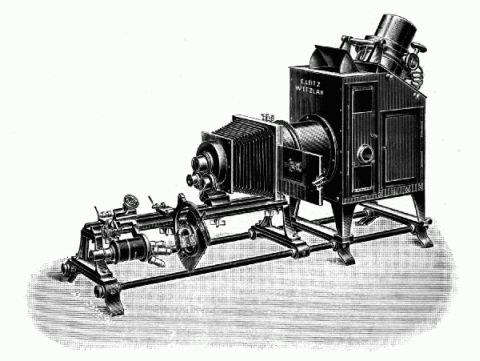
With this projection apparatus the powers of microscope objectives till number 6 may be well employed.
The picture, even when the highest powers are made use of, and the screen is at a distance of twelve feet from the apparatus, is of sufficient clearness and brightness to be available for demonstration to a large audience.
For the projection of lantern slides or of large section of tissue following parts of the apparatus are required: Lamp, condenser, cooler and bellows are the same as in the above described apparatus.[90]
The stage and objective carrier are swung to one side.
The special-projection lens of 300 mm focal distance is to be used.
A slide carrier slips into the frame of the bellows, which is sufficiently large to accommodate lantern slides 9×10 and 9×12 cm in size. The slide carrier has a stop at both ends which facilitates its adjustment in the axis of the instrument, and is arranged for the simultaneous reception of two slides, so that while one is being projected it may be charged with a second which may then without delay be pushed into the optical axis as the first is removed. In this way series of pictures may be thrown on the screen without interruption.
When so arranged the projection can be made upon a screen 30 feet from the apparatus, over the heads of an audience.
| No. 117. | Projection-lamp for current of 20 Ampères, with centering arrangement | $92.— |
| Fixed rheostat | $30.— |
(The same, adjustable $45.—.)
Lamp and rheostat are furnished at factory prices. In ordering it is well to state the strength of the available electric current, also whether it is constant or alternating.
Outfit for projection of lantern slides:
Metal-base with optical bench, triple collecting lens
(adjustable) of 150 mm aperture; large cooling cell;
slide carrier with bellows; triple revolving arm, with
rack and pinion adjustment |
$108.— | |
Projection objective of 300 mm focal length |
$20.— |
(A second objective of same focal length may be slipped over the former, the two combined represent an objective of 150 mm focus. Additional price $20.—.)
Outfit for microscopical projections:
| Cylinder-diaphragm and condenser; objectstage
and small cooler with moveable slide-holder. Objective
carrier with triple nose-piece: rack and
pinion adjustment and micrometer-screw. Broad
tube with Iris-diaphragm into which the smaller
draw-tube fits. Two projection eye-pieces. Object-stage and objective carrier are provided with hinges. Wooden cover with cloth curtain |
$84.— | |
| Transport | $250.— | |
| ——— | ||
| Complete outfit | $334.— |
| No. 118. | Megascope, apparatus for the projection of opaque objects; special offers will be made on application. | |
| No. 119. | Attachment for spectroscopic examinations, to be used on the optical bench and in connection with the lamp of the projection apparatus No. 117. Slit mechanism, large triple prism, object-stage | $80.— |
| No. 120. | Large projection apparatus, of special design with latest
improvements, for lantern slides size 13×18 cm, for
micro-projection, and megascope attachment. Special
offers for this apparatus will be made on application. (In ordering it is necessary to state the voltage
of the available electric current, also whether it is
direct or alternating.) |
|
| No. 121. | Trichinoscope. Simple electric lamp (hand feed) of
20 Ampère, mounted on adjustable stand, encased in
Russian iron box, double collecting lens (adjustable)
of 120 mm Aperture, with condensing lens. Mechanical stage for glass compressors, with movements at right angles to each other, cooling cell for the preparation with a continual flow of cold water. Objective carrier with micrometer screw, wide tube with Iris diaphragm |
$120.— |
| Projection objective of 35 mm focus, aperture f:3,5, with Iris diaphragm | $18.— | |
| ——— | ||
| $138.— |
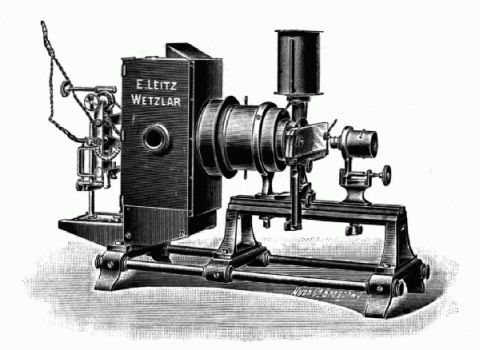
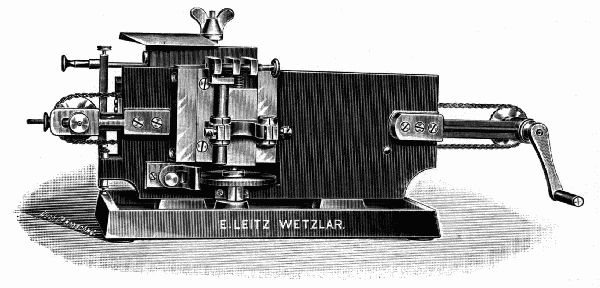
Our larger microtomes are heavy and all their adjustments are of the most accurate construction, the result being that they are very steady when in use and permit the cutting of very thin and uniform sections.[93]
They are to be had in three different sizes. The larger two are slightly different in construction from the third. The two former microtomes are provided with an automatic feed attachement. A heavy knife-carrier slides smoothly and rapidly on a horizontal track and is so arranged that it may be manipulated by the hand of the operator alone or by a wheel and chain device, which tends to assure a perfectly uniform stroke of the knife.
The objectclamp is raised vertically by a micrometer screw. This motion is accomplished by turning a large disc having teeth cut into its periphery and a turn of one tooth being equal to an elevation of 0.0025 mm.
The automatic feed is arranged as follows: With each return of the knife-carrier to the end of its track pressure is made upon an adjustable lever which regulates the motion of the micrometer wheel. This device may be so adjusted as to move the micrometer disc any number of teeth from one to ten with each sweep of the knife.
Three different forms of clamps may be had for these microtomes, and freezing apparatus as well as paraffin tables can also be fitted.
The Fixed clamp, No. 128, represented in the figure of the large sliding microtome, serves to clamp the specimen in position and does not allow any further adjustment.
The Ball and Socket clamp permits the adjustments of the specimen after it is held in the clamp by means of a ball and socket joint—see figure of No. 129—a set-screw then holds it firmly in position.
The Naples clamp permits the accurate adjustment of the specimen at any level, the clamp being supported on two horizontal axes at right angles to each other, the one controlled by rack and pinion, the other by endless screw.
The knife-carrier is arranged to hold the Thoma form knives, which are fastened by means of a wing-screw. Other knives require a special holder, such as No. 139.[94]
| No. 122. | The Large Sliding Microtome has a track 42 cm long. Its price with automatic feed attachement, wheel and chain arrangement for the knife carrier, and fixed clamp, without knife | $62.— |
| No. 123. | The same, with knife holder for Jung microtome knives | $66.— |
| No. 124. | The same, but without the wheel and chain arrangement for the knife carrier | $50.— |
| No. 125. | Medium size Sliding Microtome—Track 32 cm long; automatic feed attachement; wheel and chain motion of knife carrier and fixed specimen clamp—without knife | $56.— |
| No. 126. | The same, with knife holder for Jung microtome knives | $60.— |
| No. 127. | The same, but without wheel and chain motion | $44.— |
| No. 128. | Fixed Specimen Clamp | $4.— |
| No. 129. | Ball and Socket Clamp | $6.— |
| No. 130. | Naples Clamp | $12.— |
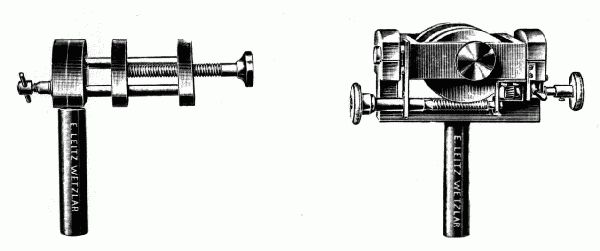
| No. 131. | The Support-Microtome has a track 19 cm long. The knife-carrier slides on a double flanged support and is moved by means of a large knob. The motion is smooth and quick. The specimen is held in a clamp supported on two adjustable axes at right angles to each other, thus permitting its adjustment in any position. The specimen carrier is moved vertically by means of a micrometer screw to which a large disc is attached. This disc is graduated, each degree representing a motion of the specimen carrier of 0,005 mm. The price of this microtome with knifeholder No. 139, without box or knife is | $34.— |
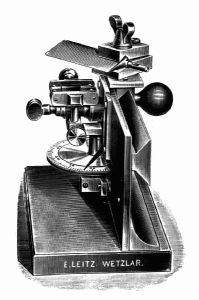
| No. 131a. | Small Sliding Microtome, length of bed 21 cm, heavy knife-carrier, object clamp for specimen 25 mm diam., micrometer screw with disc graduated into 100 degrees, each division representing a motion of 0,005 mm. Price including knifeholder No. 139, without knife | $24.— |
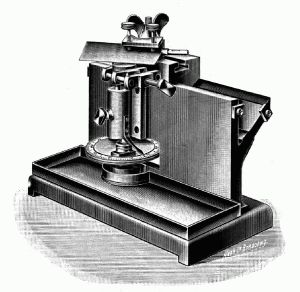
A. Thoma's Model, plano-concave, with handle adapted for clamping immediately to the knife carrier of the microtome, in box.
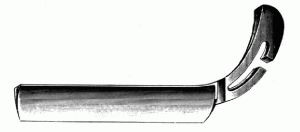
| No. 132. | Length of cutting edge 36 cm | $26.50 |
| No. 133. | " " " " 24 cm | $13.25 |
| No. 134. | " " " " 16 cm | $8.50 |
| No. 135. | " " " " 12 cm | $5.50 |
B. Jung's Model—plano-concave—requires knife-holder No. 139—in box.

| No. 136. | Length of cutting edge 24 cm | $11.25 |
| No. 137. | " " " " 17 cm | $6.— |
| No. 138. | " " " " 12 cm | $4.75 |
| No. 139. | Knife-holder designed for Jung's Microtome knife | $4.— |
| No. 140. | Freezing apparatus for Microtomes | $8.— |
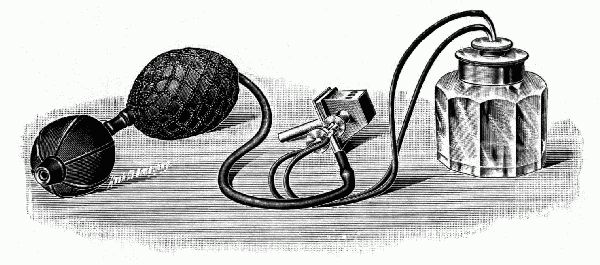
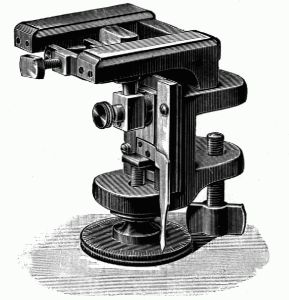
| No. 141. | This Hand Microtome, shown in the figure above, screws to the edge of the table. The specimen is held in a clamp which may be removed from the instrument, and which is raised by a micrometer screw to which a large disc is attached, the edge of which is milled and graduated, each degree of the graduation representing an elevation of the specimen of 1/100 mm. The knife is manipulated by hand and in cutting slides over two narrow glass plates which serve as a track for it. The length of this track is 7 cm | $12.— |
| No. 142. | Cylinder Microtome. The specimen is held by means of a clamp-screw in a hollow cylinder. This entire cylinder is raised within another cylinder which bears the cutting table by means of a screw with milled and graduated head. Each division of the graduation represents a motion of the inner cylinder of 1/100 mm. In cutting the edge of the knife is made to pass over the surface of the glass cutting table, the diameter of which is 7 cm | $6.— |
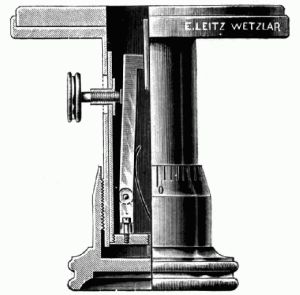
| No. 143. | Microscopic section-cutter—razor form—of best quality, plano-concave, for microtomes No. 141 and 142 | $1.25 |
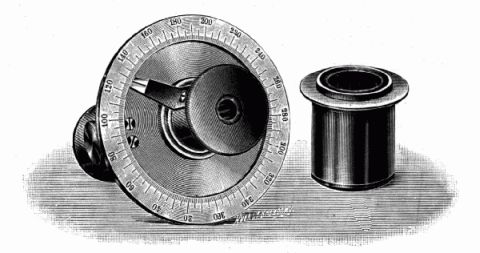
| No. 144. | Polarizing Apparatus for Food Analysis. The analizer forms part of an ocular which fits into the tube of the microscope and is provided with a graduated disc and index. It is fixed in any desired position by means of a thumb-screw. The polarizer, when used in connection with stands fitted with a substage condenser and iris-diaphragm, is hung in the carrier of the iris diaphragm; when used on other stands it takes the place of the cylinder diaphragm, and if desired may be furnished with a condenser. Price |
$22.— |
| No. 145. | Simpler Polarizing Apparatus. The analizer is without an ocular and has no graduated disc. The polarizer is as described above | $14.— |
| No. 146. | Gypsum and Mica plates set of 8 | $6.— |
| No. 147. | Coverglass Tester, for measuring the thickness of coverglasses | $3.75 |
| No. 147a. | Coverglass gauge, dial form, for the rapid and accurate measuring of coverglasses, thin plates etc. A slight pressure on a lever opens a pair of steel clips. The exact thickness is at once indicated by a pointer moving over a divided circle on the lid of a metal box. The gauge measures 0,01 up to 5 mm | $12.— |
| No. 148. | Nose-piece for two objectives—Double nose-piece | $6.— |
| No. 149. | Nose-piece for three objectives—Triple nose-piece | $8.— |
| No. 150. | Nose-piece for four objectives—Quadruple nose-piece | $10.— |
| Nose-pieces can be adjusted to our stands at any time without charge. | ||
| No. 151. | Iris-diaphragm | $6.— |

| No. 152. | Illuminating Lens on stand, 100 mm diameter | $12.— |
| No. 153. | Illuminating Lens on stand, 60 mm diameter | $8.— |
| No. 154. | Glass slides, hollow, per doz | $—.75 |
| No. 155. | Glass slides, English form 3×1", of plate-glass with polished edges, per gross | $1.— |
| No. 156. | Glass slides, with well, for moist chambers | $—.40 |
| No. 157. | Cover-glasses, squares, 15×15 mm, per 100 | $—.60 |
| No. 158. | Cover-glasses, squares, 20×20 mm, per 100 | $—.85 |
| No. 159. | Cover-glasses, circles, 15 mm diameter, per 100 | $—.85 |
| No. 160. | Cover-glasses, circles, 20 mm diameter, per 100 | $1.— |
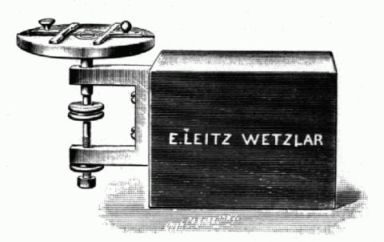
| No. 161. | Turn-table, for ringing, with adjustable slide clips | $4.— |
| No. 162. | Thickened Cedar Oil for oil-immersion lenses, 1 oz | $—.40 |
| No. 163. | Object Marker. This is designed to indicate the exact portion of an object which has been seen in the field of the microscope. After finding the required field, the objective of the microscope is unscrewed and the marker is screwed into the tube in its place. By then moving the tube so that the marker comes in contact with the object that portion of the object which occupied the optical axis of the microscope is indicated | $1.25 |
| No. 164. | Object Marker with diamond point, by means of which the object can be marked by drawing a circle | $4.— |
| No. 165. | Demonstration Ocular of Kuznitzky (Cf. Zeitschr. f.
wissensch. Mikroskopie, XIII, 1896).—Indicates any
particular portion of the image to which it is desired
to draw particular attention. A small lever at the top of the ocular moves an indicator just above the diaphragm of the ocular to any part of the field |
$3.25 |
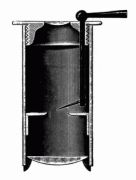
| No. 166. | Opaque Illuminator, for illuminating polished pieces of metal whose structure is to be investigated by means of high power objectives—A collar, carrying a prism, screws into the tube of the microscope, and by means of the prism sufficient light is thrown through the objective upon the otherwise opaque object to permit of its examination up to 1000 diameters magnification | $6.— |
| No. 167. | Erecting Prism—This is fastened over the ocular and erects the image received from the compound microscope, thereby materially assisting any dissection or other operation on the stage of the microscope | $7.25 |

| No. 168. | Microscope for the accurate reading of thermometer
scales, after Fridtjof Nansen. Stand with spring-clamp to attach thermometers of various sizes. With micrometer ocular and objective magnifying 12 times |
$20.— |
| No. 169. | Saccharimeter, Mitscherlich's (improved form), for
determining the amount of sugar contained in liquids,
glucose etc. by measuring the angle of rotation. Tube
with concave mirror on stand, graduated scale with vernier
and lens for reading one-tenth of a degree of rotation. The rotation of the Nicol prism with the vernier is performed by means of an endless screw. The adjustment is accomplished as soon as the two squares of the divided quartz-plate show the same color. Two tubes of 100 and 200 mm length, for the liquid to be examined, are supplied with the apparatus. Should the rotation of the substance examined be excessive, it is necessary to use sodium light for illumination |
$52.— |

| No. 170. | Case, containing a razor, spatula, two small knives, straight and curved scissors, forceps, two needles, two lancet-shaped needles | $5.50 |
| No. 171. | Case, containing a razor, spatula, a small knife, two needles, small scissors, and forceps | $4.— |
| No. 172. | Case, containing a small knife, small scissors, forceps and two needles | $2.50 |
| No. 173. | Botanical Outfit in case, containing a small knife, forceps, self-closing forceps with horn handle, two scissors, two needles and two lenses | $5.50 |
| No. 174. | Outfit for Sputum Examinations, after Kaatzer, consisting of a platinum needle, blower, cover-glass forceps, and a small rubber plate | $4.75 |
| No. 175. | Leather Microscope case to protect the mahogany case when travelling | $8.— |
| No. 176. | Leather case to protect the mahogany cases of larger size instruments | $12.— |
| No. 177. | Bell jar for covering microscope | $2.— |
1. Catalogue of microscopes etc., which has been issued in three editions, viz. in
a) English,
b) German and
c) French.
2. Anleitung zum Gebrauch des Microscops.
3. Instructions pour l'emploi des microscopes.
4. Directions for using the Microscope.
5. On the method of counting red and white corpuscles with Thoma's Apparatus.
6. Instructions pour l'emploi de l'hématimètre de Thoma.
7. Anleitung zur Mikrophotographie, mit vier Mikrophotogrammen.
8. Anleitung zum Gebrauch des Mikrospectroskops.
9. Anleitung zum Gebrauch des Oculars nach Ehrlich.
10. Description de l'oculaire d'Ehrlich.
11. Direction for using Ehrlich's eye-piece.
12. Anleitung zum Gebrauch des grossen Projectionsapparates.
13. Anleitung zum Gebrauch des Saccharimeters.
| Page | |
| Achromatic Objectives | 12 |
| Achromatic Objectives | 12 |
| Adjusting screw | 49 |
| Adjustment, coarse, fine | 17, 18 |
| Apertures | 10 |
| Aplanatic Lenses | 67 |
| Apochromatic Lenses | 14 |
| Apparatus for Blood Examinations | 70 |
| Binocular Preparation Microscope | 68 |
| Binocular Microscope after Greenough | 69 |
| Bell jar | 103 |
| Camera | 81, 84 |
| Cases for Stands | 19 |
| Cedar Oil | 101 |
| Clamps for Microtomes | 94 |
| fixed clamp | 94 |
| ball and socket clamp | 94 |
| Naples clamp | 94 |
| Compensation Eye-pieces | 14 |
| Compressors | 49 |
| Condenser | 20 |
| Corneal microscope | 69 |
| Counting chambers | 71 |
| Coverglass gauge | 99 |
| Cover-glasses | 100 |
| Cover-glasses thickness | 8 |
| Coverglass Tester | 99 |
| Cylinder Iris Diaphragm | 20, 23 |
| Cylinder Microtome | 98 |
| Demonstration Lens-holder | 67 |
| Demonstration Microscope | 49 |
| Demonstration Ocular | 101 |
| Dissecting Microscopes | 62 |
| Dissecting Microscope with erected image | 64 |
| Dissecting Stage | 66 |
| Dölken's Microscope Stand | 52 |
| Drawing Apparatus after Abbe | 74 |
| Drawing Apparatus after Tubeuf | 77 |
| Drawing Board | 76 |
| Drawing Eye-pieces | 74 |
| Edinger's Projection Apparatus | 84 |
| Engel's Alcalinity Apparatus | 72 |
| English screw | 18 |
| Erecting prism | 102 |
| Eye-pieces: | |
| Compensation Eye-piece | 14 |
| Demonstration Ocular | 101 |
| Huyghenian Eye-piece | 11 |
| Micrometer Eye-piece | 73 |
| Ehrlich's Eye-piece | 72 |
| Eye-piece with cross lines | 59 |
| Eye-piece Micrometer with squares | 73 |
| Freezing Apparatus | 97 |
| Focussing lens | 67 |
| Glass compressor | 49 |
| Glass-Micrometer for the Eye-piece | 73 |
| Glass plates, ground, clear | 82 |
| Glass slides | 100 |
| Glass slides, hollow | 100 |
| Gypsum and Mica plates | 99 |
| Greenough Binocular Microscope | 69 |
| Haemacytometer after Thoma | 71 |
| Handle for holding lens | 67 |
| Hand Microtomes | 97 |
| Hand Spectroscope | 71 |
| Horizontal Microscope | 56 |
| Illuminating Apparatus | 20 |
| Illuminating Lens | 100 |
| Immersion Objective | 12, 13 |
| Immersion Oil | 101 |
| Iris-diaphragm | 100 |
| Iris cylinder diaphragm | 20 |
| Knife-carrier | 93 |
| Knife-holder | 97 |
| Knife after Thoma | 96 |
| Knives for Microtomes | 96 |
| Lamp | 83 |
| Leather case | 103 |
| Lenses: | |
| aplanatic | 67 |
| binocular | 68 |
| for the pocket | 68 |
| Lens for Algae Examination | 65 |
| Lens-holders | 65 |
| Lens for Projection | 90 |
| Magnification | 13 |
| Mechanical Stages | 78 |
| Megascope | 91 |
| Micrometers | 73 |
| Micrometer Eye-piece | 73 |
| Micrometer with squares | 73 |
| Micrometer-screw | 18 |
| Microscope after Dölken | 52 |
| " " Nebelthau | 50 |
| " " Unna | 33 |
| " stereoscopic | 69 |
| " mineralogical | 57 |
| " for dissections | 62 |
| " for reading thermometer scales | 102 |
| " for the examination of trichinae | 48 |
| Microscopical Cases | 103 |
| Micro-Spectroscope | 70 |
| Microtomes | 92 |
| Microtome knives | 96 |
| Moist chamber | 100 |
| Nansen's Microscope | 102 |
| Nebelthau's Microscope | 50 |
| Net micrometers | 73 |
| Nose-pieces | 100 |
| Notice | 4 |
| Object Marker | 101 |
| Objectives achromatic | 12 |
| " apochromatic | 14 |
| " photographic | 85 |
| Ocular for Demonstrations | 101 |
| Oil-Immersion | 12, 14 |
| Opaque illuminator | 102 |
| Outfit for Sputum Examinations | 103 |
| Photographic Objectives | 85 |
| Photographic plates | 82, 85 |
| Photomicrography | 82 |
| Photo-micrographic Apparatus | 82 |
| Photomicrographic Apparatus with joint for inclination | 83 |
| Pfeiffer dissecting microscope | 64 |
| Pipettes | 70 |
| Plate holders | 82, 85 |
| Pocket Microscope | 65 |
| Pocket Lens | 68 |
| Polarizing Apparatus | 99 |
| Preface | 6 |
| Projection | 87 |
| Projection Apparatus, large size | 91 |
| Projection Apparatus after Edinger | 84 |
| Projection-lamp | 90 |
| Projection-lens | 90 |
| Projection-ocular | 91 |
| Publications | 104 |
| Reflector | 83 |
| Revolving Eye-piece | 15 |
| Rheostat | 90 |
| Saccharimeter, Mitcherlich | 102 |
| Screw-micrometer eye-piece | 73 |
| Simple dissecting microscope, wood case, with handrests | 66 |
| Sliding Microscope (Nebelthau's) | 50 |
| Sliding Microtome | 92, 95 |
| Slide for counting the corpuscles of the blood | 71 |
| Spectroscope | 70 |
| Stage-Micrometer | 73 |
| Stage for Dissections | 66 |
| Stand for supporting specimens | 83 |
| Stand A | 24 |
| Stand I | 28 |
| Stereoscopic Binocular stand | 69 |
| Stand Ia | 30 |
| " Ia with English Foot | 32 |
| " Ib | 34 |
| " II | 36 |
| " IIa | 38 |
| " IIb | 40 |
| " III | 42 |
| " IV | 44 |
| " V | 46 |
| " VI | 48 |
| " I for Mineralogical Research | 57 |
| " II " " " | 60 |
| Stereoscopic Microscope | 69 |
| Swing-out Condenser | 20 |
| Thoma's Haemacytometer | 71 |
| Thoma Knives | 96 |
| Travelling Microscopes | 53 |
| Trichinoscope | 91 |
| Tube length | 8 |
| Tubeuf drawing Apparatus | 77 |
| Turn-table | 101 |
| Türck counting chamber | 72 |
| Unna's Microscope | 33 |
| Warm Stages | 80 |
| Water-Immersion | 12 |
| Welsbach lamp | 83 |
End of Project Gutenberg's Microscopes and Accessory Apparatus, by Ernst Leitz
*** END OF THIS PROJECT GUTENBERG EBOOK MICROSCOPES, ACCESSORY APPARATUS ***
***** This file should be named 35842-h.htm or 35842-h.zip *****
This and all associated files of various formats will be found in:
http://www.gutenberg.org/3/5/8/4/35842/
Produced by Barbara Watson, Ross Cooling and the Online
Distributed Proofreading Canada Team at
http://www.pgdpcanada.net
Updated editions will replace the previous one--the old editions
will be renamed.
Creating the works from public domain print editions means that no
one owns a United States copyright in these works, so the Foundation
(and you!) can copy and distribute it in the United States without
permission and without paying copyright royalties. Special rules,
set forth in the General Terms of Use part of this license, apply to
copying and distributing Project Gutenberg-tm electronic works to
protect the PROJECT GUTENBERG-tm concept and trademark. Project
Gutenberg is a registered trademark, and may not be used if you
charge for the eBooks, unless you receive specific permission. If you
do not charge anything for copies of this eBook, complying with the
rules is very easy. You may use this eBook for nearly any purpose
such as creation of derivative works, reports, performances and
research. They may be modified and printed and given away--you may do
practically ANYTHING with public domain eBooks. Redistribution is
subject to the trademark license, especially commercial
redistribution.
*** START: FULL LICENSE ***
THE FULL PROJECT GUTENBERG LICENSE
PLEASE READ THIS BEFORE YOU DISTRIBUTE OR USE THIS WORK
To protect the Project Gutenberg-tm mission of promoting the free
distribution of electronic works, by using or distributing this work
(or any other work associated in any way with the phrase "Project
Gutenberg"), you agree to comply with all the terms of the Full Project
Gutenberg-tm License (available with this file or online at
http://gutenberg.net/license).
Section 1. General Terms of Use and Redistributing Project Gutenberg-tm
electronic works
1.A. By reading or using any part of this Project Gutenberg-tm
electronic work, you indicate that you have read, understand, agree to
and accept all the terms of this license and intellectual property
(trademark/copyright) agreement. If you do not agree to abide by all
the terms of this agreement, you must cease using and return or destroy
all copies of Project Gutenberg-tm electronic works in your possession.
If you paid a fee for obtaining a copy of or access to a Project
Gutenberg-tm electronic work and you do not agree to be bound by the
terms of this agreement, you may obtain a refund from the person or
entity to whom you paid the fee as set forth in paragraph 1.E.8.
1.B. "Project Gutenberg" is a registered trademark. It may only be
used on or associated in any way with an electronic work by people who
agree to be bound by the terms of this agreement. There are a few
things that you can do with most Project Gutenberg-tm electronic works
even without complying with the full terms of this agreement. See
paragraph 1.C below. There are a lot of things you can do with Project
Gutenberg-tm electronic works if you follow the terms of this agreement
and help preserve free future access to Project Gutenberg-tm electronic
works. See paragraph 1.E below.
1.C. The Project Gutenberg Literary Archive Foundation ("the Foundation"
or PGLAF), owns a compilation copyright in the collection of Project
Gutenberg-tm electronic works. Nearly all the individual works in the
collection are in the public domain in the United States. If an
individual work is in the public domain in the United States and you are
located in the United States, we do not claim a right to prevent you from
copying, distributing, performing, displaying or creating derivative
works based on the work as long as all references to Project Gutenberg
are removed. Of course, we hope that you will support the Project
Gutenberg-tm mission of promoting free access to electronic works by
freely sharing Project Gutenberg-tm works in compliance with the terms of
this agreement for keeping the Project Gutenberg-tm name associated with
the work. You can easily comply with the terms of this agreement by
keeping this work in the same format with its attached full Project
Gutenberg-tm License when you share it without charge with others.
1.D. The copyright laws of the place where you are located also govern
what you can do with this work. Copyright laws in most countries are in
a constant state of change. If you are outside the United States, check
the laws of your country in addition to the terms of this agreement
before downloading, copying, displaying, performing, distributing or
creating derivative works based on this work or any other Project
Gutenberg-tm work. The Foundation makes no representations concerning
the copyright status of any work in any country outside the United
States.
1.E. Unless you have removed all references to Project Gutenberg:
1.E.1. The following sentence, with active links to, or other immediate
access to, the full Project Gutenberg-tm License must appear prominently
whenever any copy of a Project Gutenberg-tm work (any work on which the
phrase "Project Gutenberg" appears, or with which the phrase "Project
Gutenberg" is associated) is accessed, displayed, performed, viewed,
copied or distributed:
This eBook is for the use of anyone anywhere at no cost and with
almost no restrictions whatsoever. You may copy it, give it away or
re-use it under the terms of the Project Gutenberg License included
with this eBook or online at www.gutenberg.net
1.E.2. If an individual Project Gutenberg-tm electronic work is derived
from the public domain (does not contain a notice indicating that it is
posted with permission of the copyright holder), the work can be copied
and distributed to anyone in the United States without paying any fees
or charges. If you are redistributing or providing access to a work
with the phrase "Project Gutenberg" associated with or appearing on the
work, you must comply either with the requirements of paragraphs 1.E.1
through 1.E.7 or obtain permission for the use of the work and the
Project Gutenberg-tm trademark as set forth in paragraphs 1.E.8 or
1.E.9.
1.E.3. If an individual Project Gutenberg-tm electronic work is posted
with the permission of the copyright holder, your use and distribution
must comply with both paragraphs 1.E.1 through 1.E.7 and any additional
terms imposed by the copyright holder. Additional terms will be linked
to the Project Gutenberg-tm License for all works posted with the
permission of the copyright holder found at the beginning of this work.
1.E.4. Do not unlink or detach or remove the full Project Gutenberg-tm
License terms from this work, or any files containing a part of this
work or any other work associated with Project Gutenberg-tm.
1.E.5. Do not copy, display, perform, distribute or redistribute this
electronic work, or any part of this electronic work, without
prominently displaying the sentence set forth in paragraph 1.E.1 with
active links or immediate access to the full terms of the Project
Gutenberg-tm License.
1.E.6. You may convert to and distribute this work in any binary,
compressed, marked up, nonproprietary or proprietary form, including any
word processing or hypertext form. However, if you provide access to or
distribute copies of a Project Gutenberg-tm work in a format other than
"Plain Vanilla ASCII" or other format used in the official version
posted on the official Project Gutenberg-tm web site (www.gutenberg.net),
you must, at no additional cost, fee or expense to the user, provide a
copy, a means of exporting a copy, or a means of obtaining a copy upon
request, of the work in its original "Plain Vanilla ASCII" or other
form. Any alternate format must include the full Project Gutenberg-tm
License as specified in paragraph 1.E.1.
1.E.7. Do not charge a fee for access to, viewing, displaying,
performing, copying or distributing any Project Gutenberg-tm works
unless you comply with paragraph 1.E.8 or 1.E.9.
1.E.8. You may charge a reasonable fee for copies of or providing
access to or distributing Project Gutenberg-tm electronic works provided
that
- You pay a royalty fee of 20% of the gross profits you derive from
the use of Project Gutenberg-tm works calculated using the method
you already use to calculate your applicable taxes. The fee is
owed to the owner of the Project Gutenberg-tm trademark, but he
has agreed to donate royalties under this paragraph to the
Project Gutenberg Literary Archive Foundation. Royalty payments
must be paid within 60 days following each date on which you
prepare (or are legally required to prepare) your periodic tax
returns. Royalty payments should be clearly marked as such and
sent to the Project Gutenberg Literary Archive Foundation at the
address specified in Section 4, "Information about donations to
the Project Gutenberg Literary Archive Foundation."
- You provide a full refund of any money paid by a user who notifies
you in writing (or by e-mail) within 30 days of receipt that s/he
does not agree to the terms of the full Project Gutenberg-tm
License. You must require such a user to return or
destroy all copies of the works possessed in a physical medium
and discontinue all use of and all access to other copies of
Project Gutenberg-tm works.
- You provide, in accordance with paragraph 1.F.3, a full refund of any
money paid for a work or a replacement copy, if a defect in the
electronic work is discovered and reported to you within 90 days
of receipt of the work.
- You comply with all other terms of this agreement for free
distribution of Project Gutenberg-tm works.
1.E.9. If you wish to charge a fee or distribute a Project Gutenberg-tm
electronic work or group of works on different terms than are set
forth in this agreement, you must obtain permission in writing from
both the Project Gutenberg Literary Archive Foundation and Michael
Hart, the owner of the Project Gutenberg-tm trademark. Contact the
Foundation as set forth in Section 3 below.
1.F.
1.F.1. Project Gutenberg volunteers and employees expend considerable
effort to identify, do copyright research on, transcribe and proofread
public domain works in creating the Project Gutenberg-tm
collection. Despite these efforts, Project Gutenberg-tm electronic
works, and the medium on which they may be stored, may contain
"Defects," such as, but not limited to, incomplete, inaccurate or
corrupt data, transcription errors, a copyright or other intellectual
property infringement, a defective or damaged disk or other medium, a
computer virus, or computer codes that damage or cannot be read by
your equipment.
1.F.2. LIMITED WARRANTY, DISCLAIMER OF DAMAGES - Except for the "Right
of Replacement or Refund" described in paragraph 1.F.3, the Project
Gutenberg Literary Archive Foundation, the owner of the Project
Gutenberg-tm trademark, and any other party distributing a Project
Gutenberg-tm electronic work under this agreement, disclaim all
liability to you for damages, costs and expenses, including legal
fees. YOU AGREE THAT YOU HAVE NO REMEDIES FOR NEGLIGENCE, STRICT
LIABILITY, BREACH OF WARRANTY OR BREACH OF CONTRACT EXCEPT THOSE
PROVIDED IN PARAGRAPH 1.F.3. YOU AGREE THAT THE FOUNDATION, THE
TRADEMARK OWNER, AND ANY DISTRIBUTOR UNDER THIS AGREEMENT WILL NOT BE
LIABLE TO YOU FOR ACTUAL, DIRECT, INDIRECT, CONSEQUENTIAL, PUNITIVE OR
INCIDENTAL DAMAGES EVEN IF YOU GIVE NOTICE OF THE POSSIBILITY OF SUCH
DAMAGE.
1.F.3. LIMITED RIGHT OF REPLACEMENT OR REFUND - If you discover a
defect in this electronic work within 90 days of receiving it, you can
receive a refund of the money (if any) you paid for it by sending a
written explanation to the person you received the work from. If you
received the work on a physical medium, you must return the medium with
your written explanation. The person or entity that provided you with
the defective work may elect to provide a replacement copy in lieu of a
refund. If you received the work electronically, the person or entity
providing it to you may choose to give you a second opportunity to
receive the work electronically in lieu of a refund. If the second copy
is also defective, you may demand a refund in writing without further
opportunities to fix the problem.
1.F.4. Except for the limited right of replacement or refund set forth
in paragraph 1.F.3, this work is provided to you 'AS-IS' WITH NO OTHER
WARRANTIES OF ANY KIND, EXPRESS OR IMPLIED, INCLUDING BUT NOT LIMITED TO
WARRANTIES OF MERCHANTIBILITY OR FITNESS FOR ANY PURPOSE.
1.F.5. Some states do not allow disclaimers of certain implied
warranties or the exclusion or limitation of certain types of damages.
If any disclaimer or limitation set forth in this agreement violates the
law of the state applicable to this agreement, the agreement shall be
interpreted to make the maximum disclaimer or limitation permitted by
the applicable state law. The invalidity or unenforceability of any
provision of this agreement shall not void the remaining provisions.
1.F.6. INDEMNITY - You agree to indemnify and hold the Foundation, the
trademark owner, any agent or employee of the Foundation, anyone
providing copies of Project Gutenberg-tm electronic works in accordance
with this agreement, and any volunteers associated with the production,
promotion and distribution of Project Gutenberg-tm electronic works,
harmless from all liability, costs and expenses, including legal fees,
that arise directly or indirectly from any of the following which you do
or cause to occur: (a) distribution of this or any Project Gutenberg-tm
work, (b) alteration, modification, or additions or deletions to any
Project Gutenberg-tm work, and (c) any Defect you cause.
Section 2. Information about the Mission of Project Gutenberg-tm
Project Gutenberg-tm is synonymous with the free distribution of
electronic works in formats readable by the widest variety of computers
including obsolete, old, middle-aged and new computers. It exists
because of the efforts of hundreds of volunteers and donations from
people in all walks of life.
Volunteers and financial support to provide volunteers with the
assistance they need are critical to reaching Project Gutenberg-tm's
goals and ensuring that the Project Gutenberg-tm collection will
remain freely available for generations to come. In 2001, the Project
Gutenberg Literary Archive Foundation was created to provide a secure
and permanent future for Project Gutenberg-tm and future generations.
To learn more about the Project Gutenberg Literary Archive Foundation
and how your efforts and donations can help, see Sections 3 and 4
and the Foundation web page at http://www.pglaf.org.
Section 3. Information about the Project Gutenberg Literary Archive
Foundation
The Project Gutenberg Literary Archive Foundation is a non profit
501(c)(3) educational corporation organized under the laws of the
state of Mississippi and granted tax exempt status by the Internal
Revenue Service. The Foundation's EIN or federal tax identification
number is 64-6221541. Its 501(c)(3) letter is posted at
http://pglaf.org/fundraising. Contributions to the Project Gutenberg
Literary Archive Foundation are tax deductible to the full extent
permitted by U.S. federal laws and your state's laws.
The Foundation's principal office is located at 4557 Melan Dr. S.
Fairbanks, AK, 99712., but its volunteers and employees are scattered
throughout numerous locations. Its business office is located at
809 North 1500 West, Salt Lake City, UT 84116, (801) 596-1887, email
business@pglaf.org. Email contact links and up to date contact
information can be found at the Foundation's web site and official
page at http://pglaf.org
For additional contact information:
Dr. Gregory B. Newby
Chief Executive and Director
gbnewby@pglaf.org
Section 4. Information about Donations to the Project Gutenberg
Literary Archive Foundation
Project Gutenberg-tm depends upon and cannot survive without wide
spread public support and donations to carry out its mission of
increasing the number of public domain and licensed works that can be
freely distributed in machine readable form accessible by the widest
array of equipment including outdated equipment. Many small donations
($1 to $5,000) are particularly important to maintaining tax exempt
status with the IRS.
The Foundation is committed to complying with the laws regulating
charities and charitable donations in all 50 states of the United
States. Compliance requirements are not uniform and it takes a
considerable effort, much paperwork and many fees to meet and keep up
with these requirements. We do not solicit donations in locations
where we have not received written confirmation of compliance. To
SEND DONATIONS or determine the status of compliance for any
particular state visit http://pglaf.org
While we cannot and do not solicit contributions from states where we
have not met the solicitation requirements, we know of no prohibition
against accepting unsolicited donations from donors in such states who
approach us with offers to donate.
International donations are gratefully accepted, but we cannot make
any statements concerning tax treatment of donations received from
outside the United States. U.S. laws alone swamp our small staff.
Please check the Project Gutenberg Web pages for current donation
methods and addresses. Donations are accepted in a number of other
ways including including checks, online payments and credit card
donations. To donate, please visit: http://pglaf.org/donate
Section 5. General Information About Project Gutenberg-tm electronic
works.
Professor Michael S. Hart is the originator of the Project Gutenberg-tm
concept of a library of electronic works that could be freely shared
with anyone. For thirty years, he produced and distributed Project
Gutenberg-tm eBooks with only a loose network of volunteer support.
Project Gutenberg-tm eBooks are often created from several printed
editions, all of which are confirmed as Public Domain in the U.S.
unless a copyright notice is included. Thus, we do not necessarily
keep eBooks in compliance with any particular paper edition.
Most people start at our Web site which has the main PG search facility:
http://www.gutenberg.net
This Web site includes information about Project Gutenberg-tm,
including how to make donations to the Project Gutenberg Literary
Archive Foundation, how to help produce our new eBooks, and how to
subscribe to our email newsletter to hear about new eBooks.